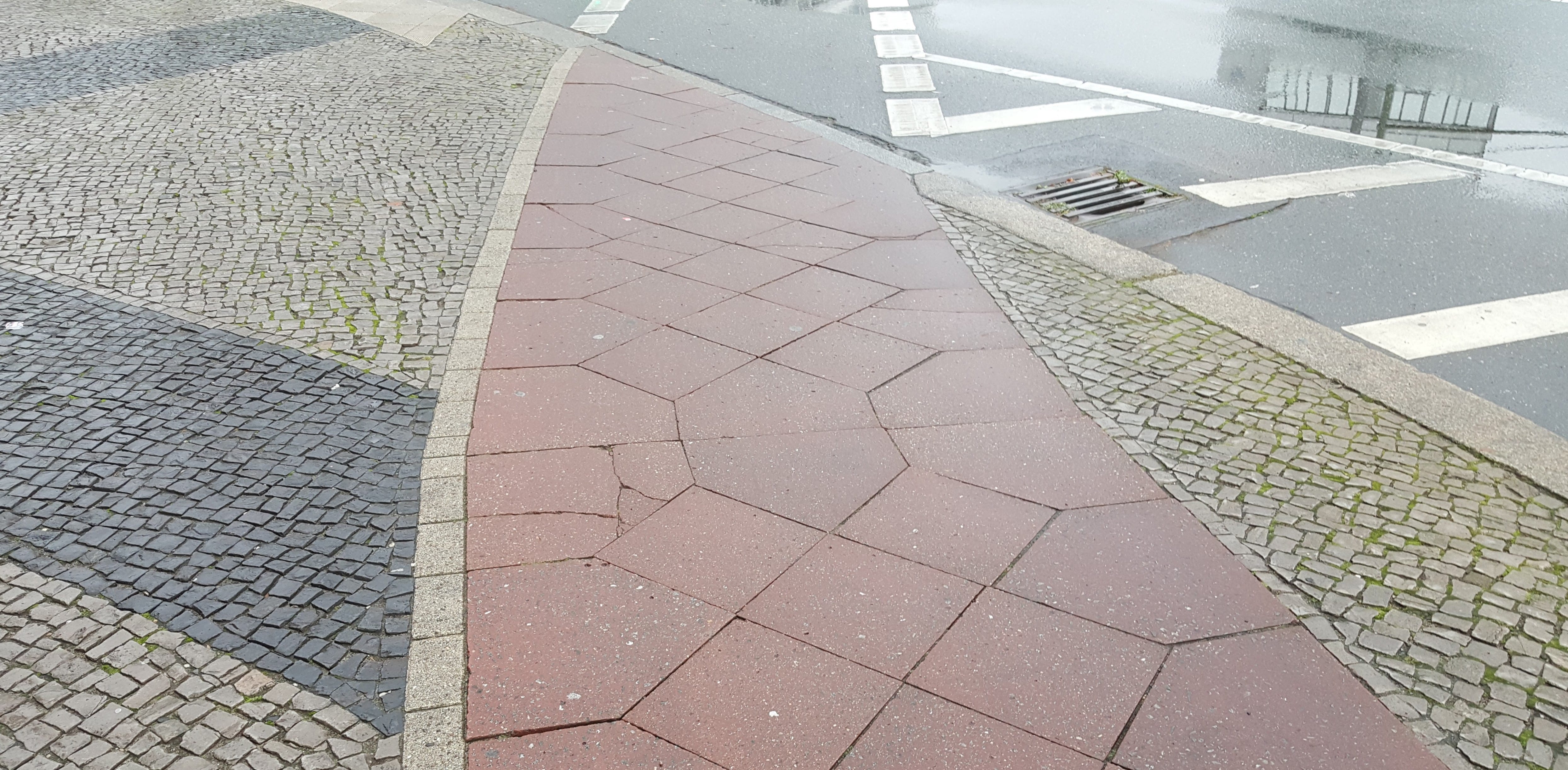
Berlin’s main thoroughfares include designated lanes for pedestrians, bicycles, cars, and public transport. Often, the lanes are distinguished by different paving materials
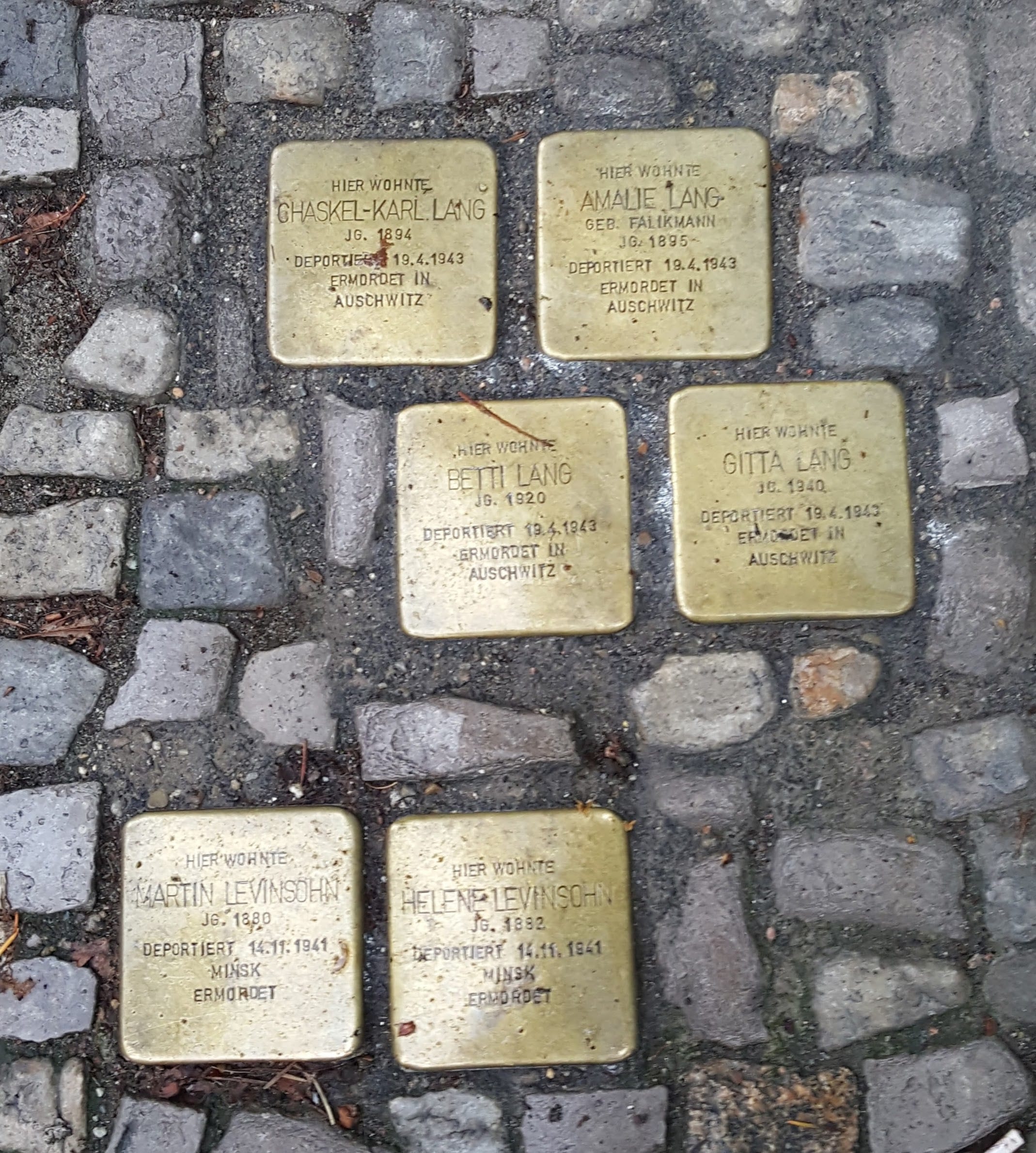
As we walked toward the bus stop, Marty pointed out these tiny plaques among the paving stones in the sidewalk near his apartment. They are memorials to Jews who once lived in this neighborhood but were deported to Nazi concentration camps and never returned
Our goal for this morning was to arrive at the Reichstag building before the ticket office opened at 8:00 a.m. so we could get in line to visit the big glass dome and rooftop terrace. We had learned too late that advance registration was required, but Marty said that it might be possible to get tickets if the day’s allotment had not already been filled. So we rose earlier than any of us normally does on a Sunday, enjoyed another excellent Marty-made breakfast featuring Polish sausage, meatballs, Apfelkuchen (apple cakes), bananas, and raspberries, and then all caught a bus heading for Berlin’s federal office district.
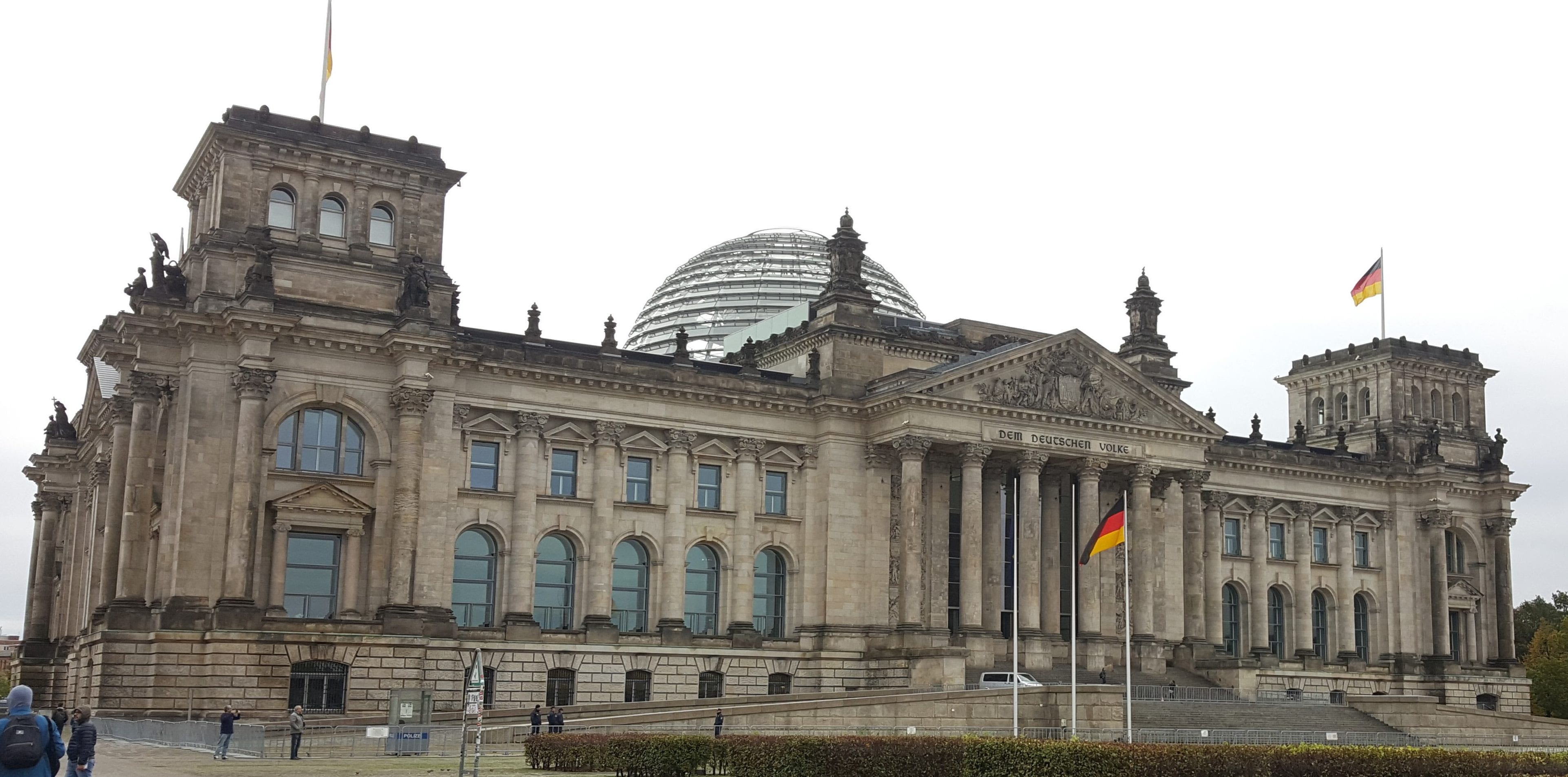
The Reichstag building
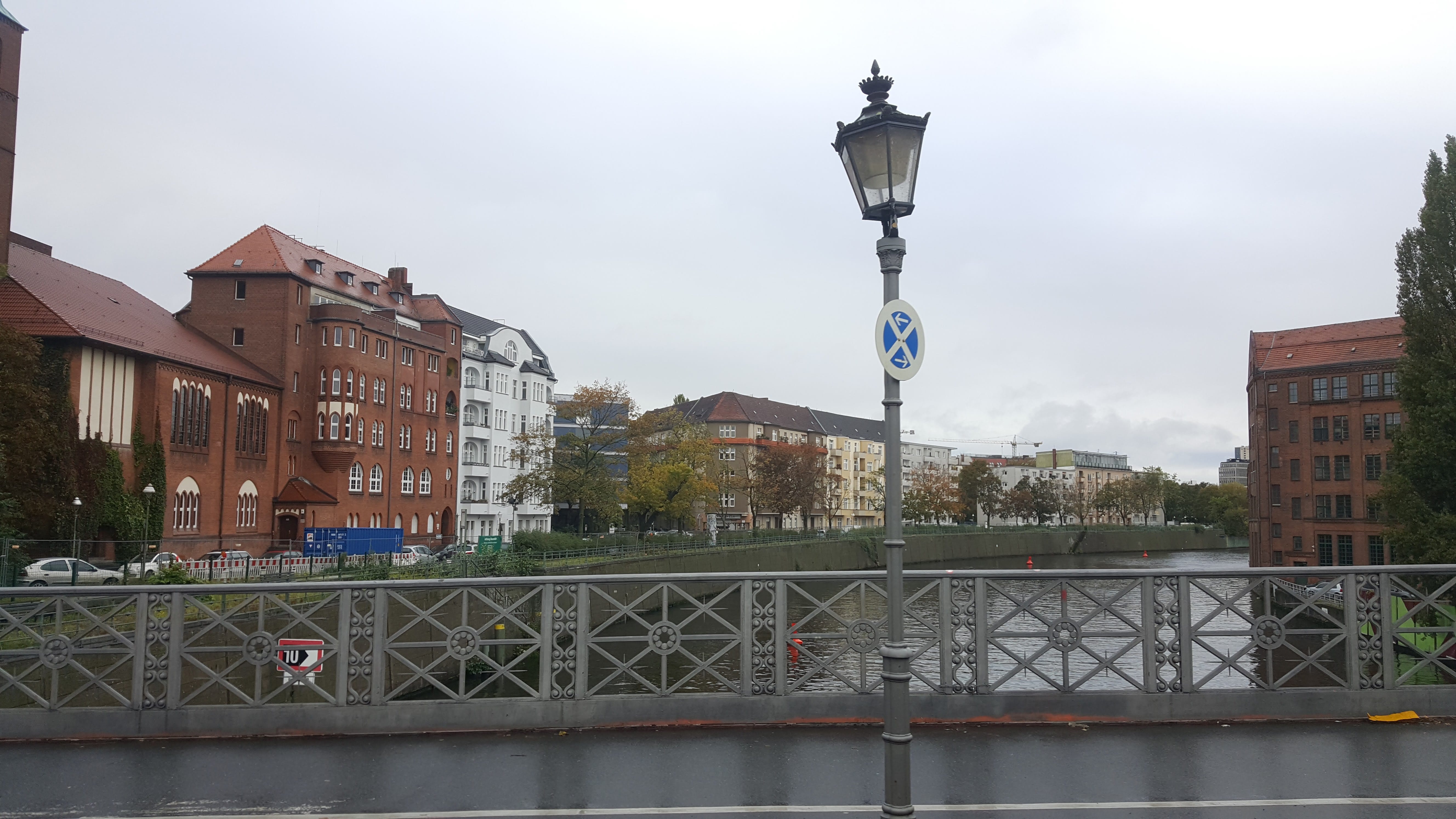
Crossing the Spree River somewhere along the bus route to the Reichstag building
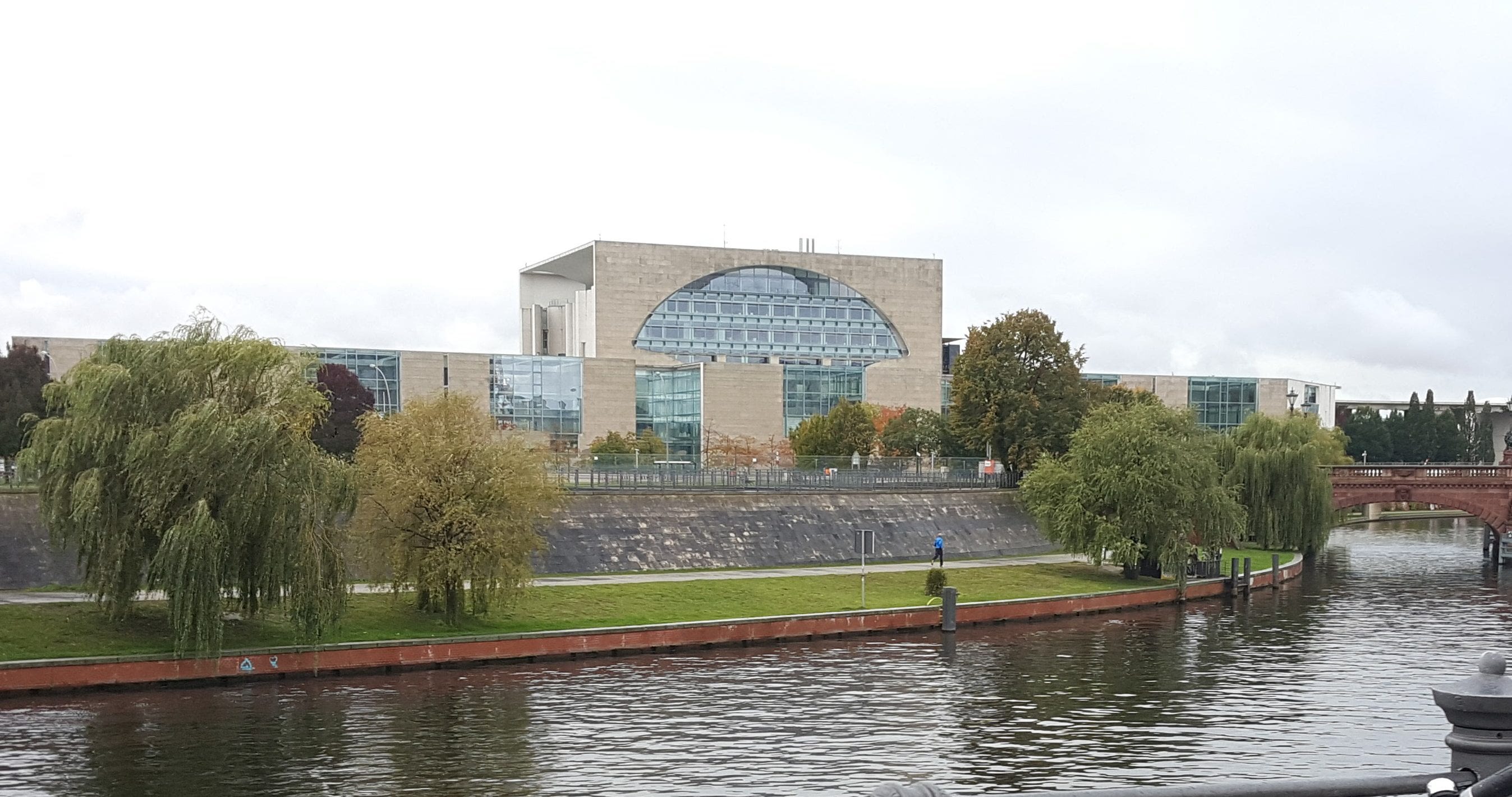
The Paul-Löbe House, one of many Bundestag office complexes situated along the Spree near the Reichstag building
The Reichstag building, seat of the reunified German Bundestag (parliament) since 1999, was originally built about a hundred years earlier as the home of the Imperial Diet (Reichstag). The term Reichstag persisted as the name of the German parliament during the Weimar Republic and Nazi eras, and stuck to the building even though fire damage had rendered it useless by 1935. Reconstruction began soon after reunification in the 1990s. Like the Berliner Schloss, much of the nineteenth-century exterior design was retained, but the original cupola was replaced with a modern glass dome. Said to offer magnificent views from its rooftop terrace, the Reichstag building is now one of the most visited buildings in Berlin.
Unfortunately, we would not get to see those views. The only tickets still available today would not grant us entrance until 21:00 (9 p.m.), so we took some photos outside and moved to Plan B: attending the 10 a.m. Sunday service at the Berliner Dom.
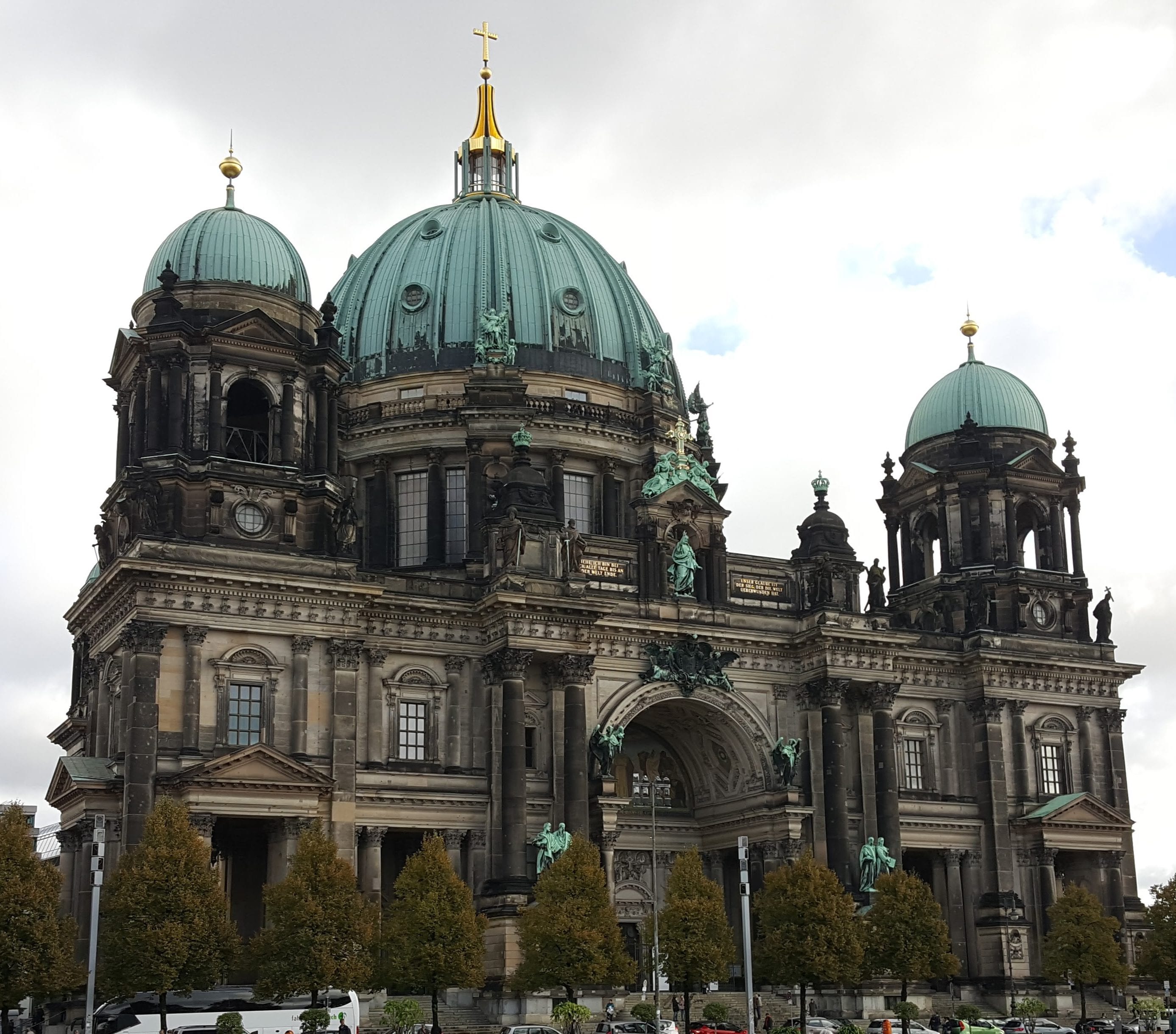
The Berliner Dom
This was a highly satisfactory alternative because the service would feature the Berliner Domkantorei (cathedral choir) and chamber orchestra performing a mass by Franz Schubert, as well as other great music played on the cathedral’s massive organ. Attending a worship service also gave us the opportunity to more appropriately observe the Sabbath–even though we couldn’t completely understand the sermon, which was delivered by Dompredigerin Dr. Petra Zimmermann. We could, however, read her text (Mark 9:17-17) from the digitized scriptures on our ever-present devices, and consider the story of the father whose son was tormented by a “foul spirit” and implored Jesus for divine help. Other biblical passages read during the service (Matthew 15:21-28 and Romans 10:9-17) also caused us to reflect on the power of faith and the miracles that can occur when we, like the father of the afflicted boy, cry out, “Lord, I believe. Help thou mine unbelief.”
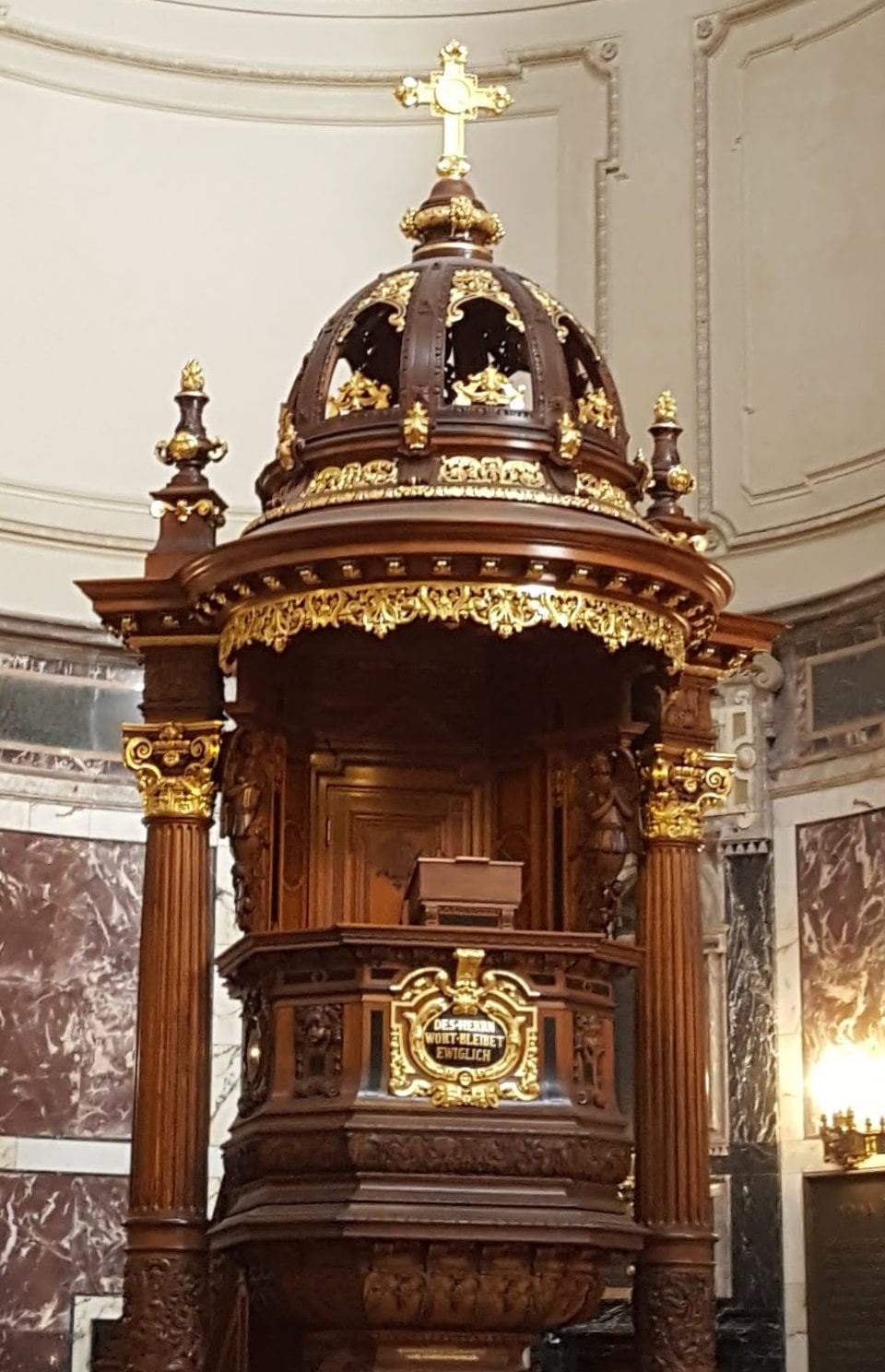
The Dompredigerin (preacher) delivered her sermon from this pulpit
While Michael was intently focused on trying to understand as much of the spoken German as possible, Nancy allowed her eyes to wander around the cathedral’s interior. Martin Luther, John Calvin, Ulrich Zwingli, Phillipp Melenchthon, and other prominent figures in the history of the Reformation are represented in a ring of statues at the base of the building’s central dome. These figures were labeled, but figuring out which biblical stories the bas-relief sculptures above their heads depicted required more careful examination. Nancy recognized the stoning of Stephen, Paul’s conversion, Paul preaching in Athens, and Peter healing a lame man–all acts of the apostles.

Zwingli and Luther flank a bas-relief depicting the stoning of Stephen in the Berliner Dom
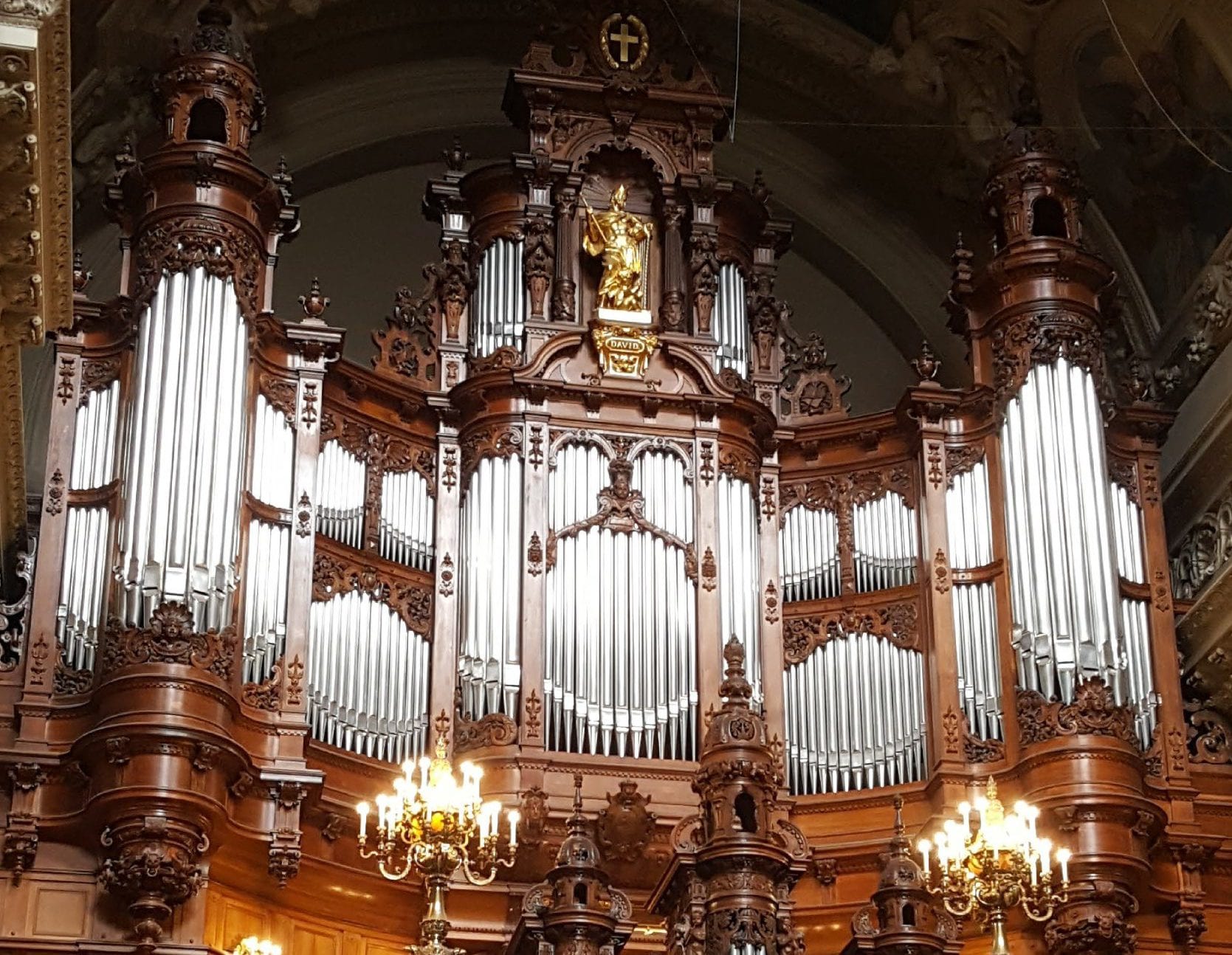
The cathedral’s organ has 7,269 pipes, 113 registers, and four manuals. The sound it produces mimics that of a full-blown late-Romantic-period symphony orchestra
None of the cathedral’s ornamental artwork depicts Jesus Christ: no crucifixes, no nativities, no Sermon on the Mount. Over the centuries, most Christian churches have depended on artwork to educate the illiterate and hold the attention of those who couldn’t understand Latin (or, in Nancy’s case, German), but the decorators of the Berliner Dom apparently adhered to the Calvinistic notion that the Second Commandment forbids the creation of any images of deity, even if the intent is simply to illustrate rather than to create an object of worship.
The Berliner Dom occupies part of an island in the Spree River known simply as Museumsinsel (Museum Island) because there are at least half a dozen major museums located there.

Snack time at the Museum Cafe
The three of us intended to visit the Pergamon Museum following the church service–but first we needed a snack. We walked across a nearby bridge to the Museumscafé, where we ordered hot chocolate, warm pretzels, and a wedge of apfelkuchen.
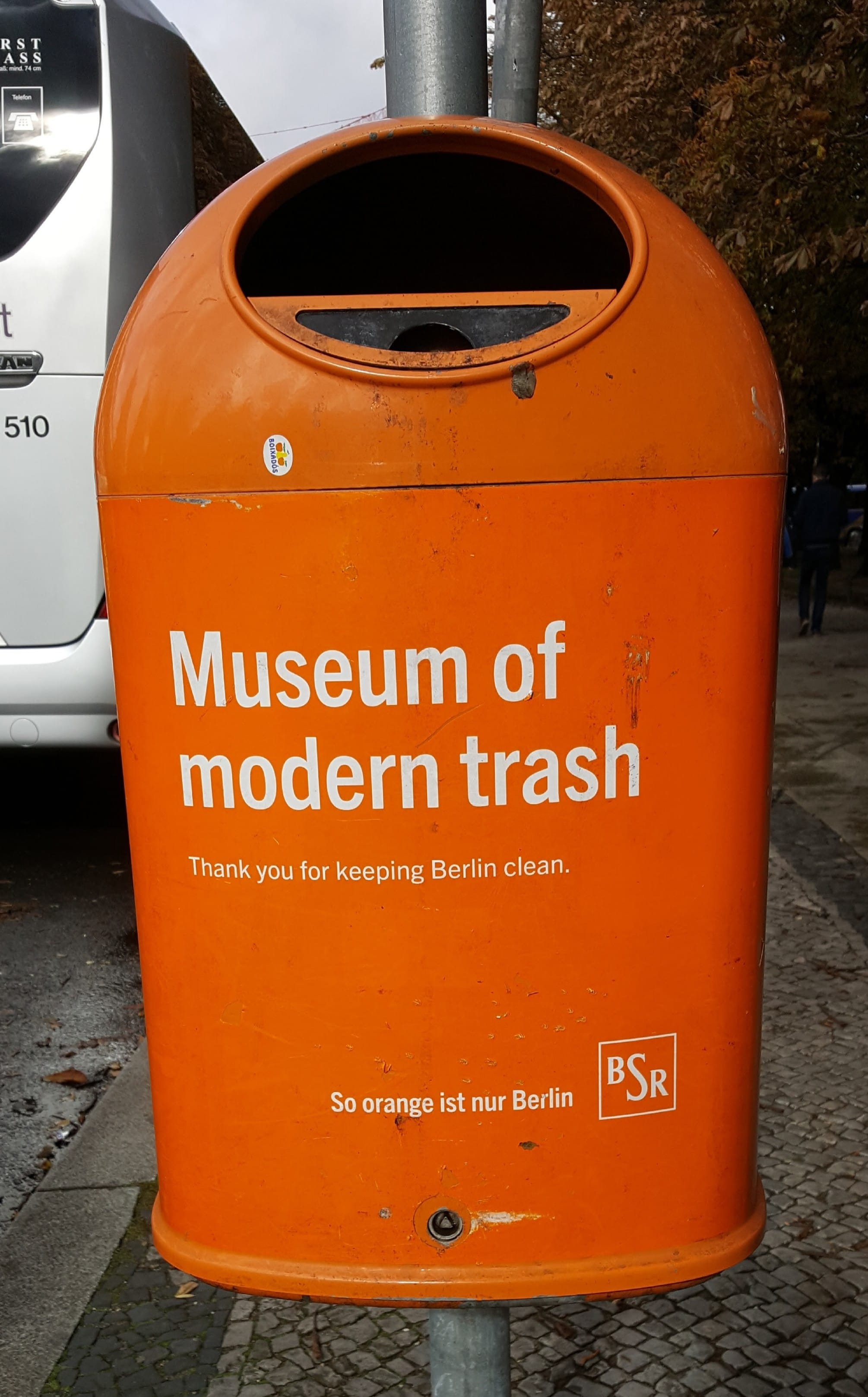
Interesting that this bin should be labeled in English rather than in German
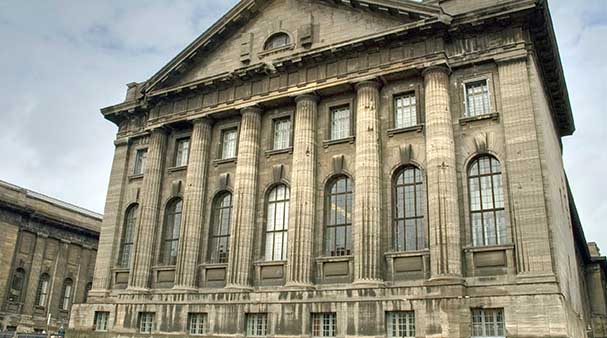
Pergamon Museum
Years ago, when both Nancy and Michael were freshman Humanities majors at Brigham Young University, we studied photos of the enormous, ancient Altar of Zeus and the even more enormous, even more ancient Ishtar Gate, both of which had been removed from their original locations (Pergamon, in what is now Turkey, and Babylon, in what is now Iraq, respectively) and painstakingly reconstructed in a specially-built museum in Berlin. Because the Pergamon Museum was “behind the Iron Curtain” at the time we first learned about it, it seemed unlikely that either of us would ever have a chance to visit so we could see these famous antiquities with our own eyes.
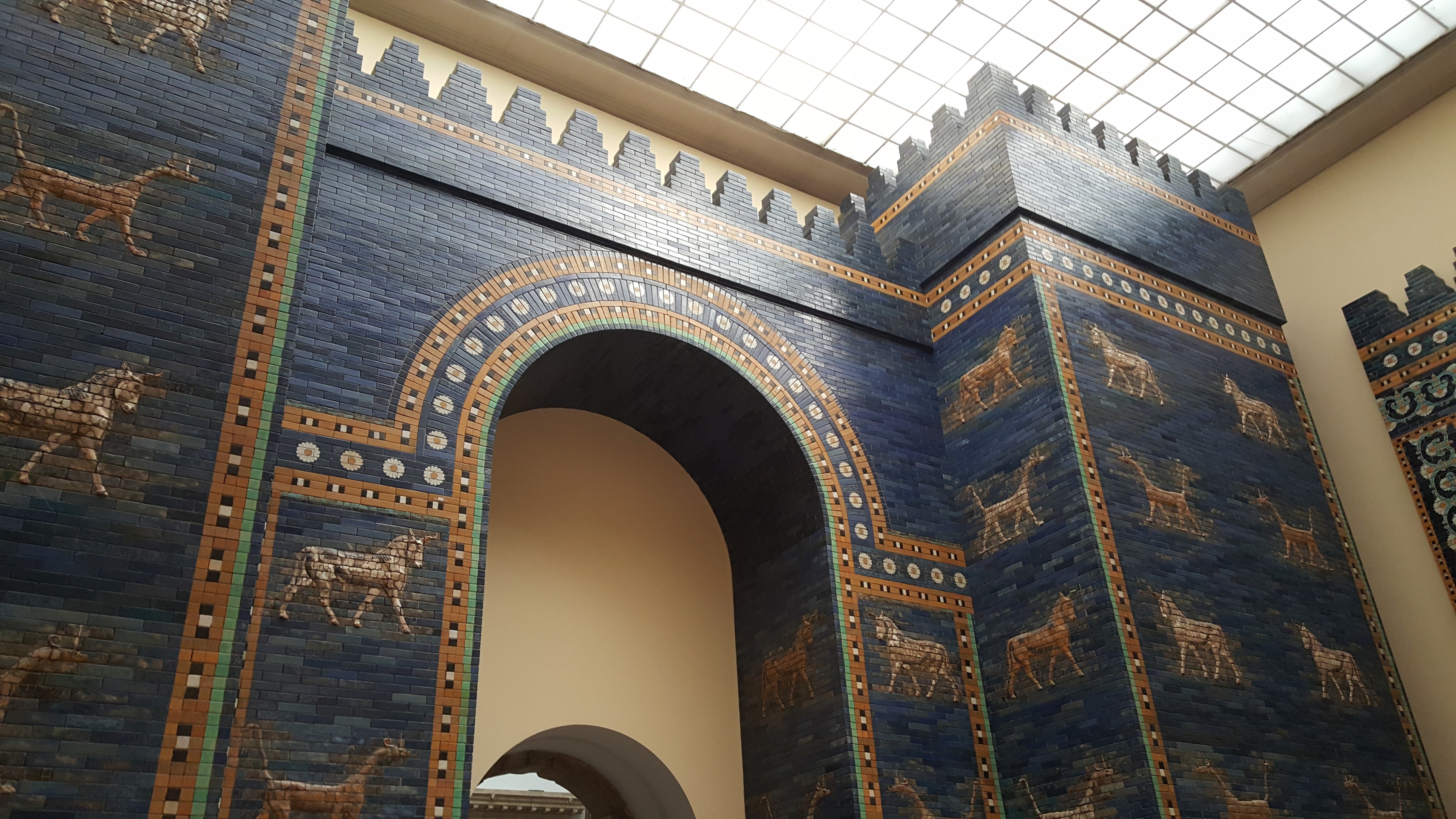
Central portion of the Ishtar Gate
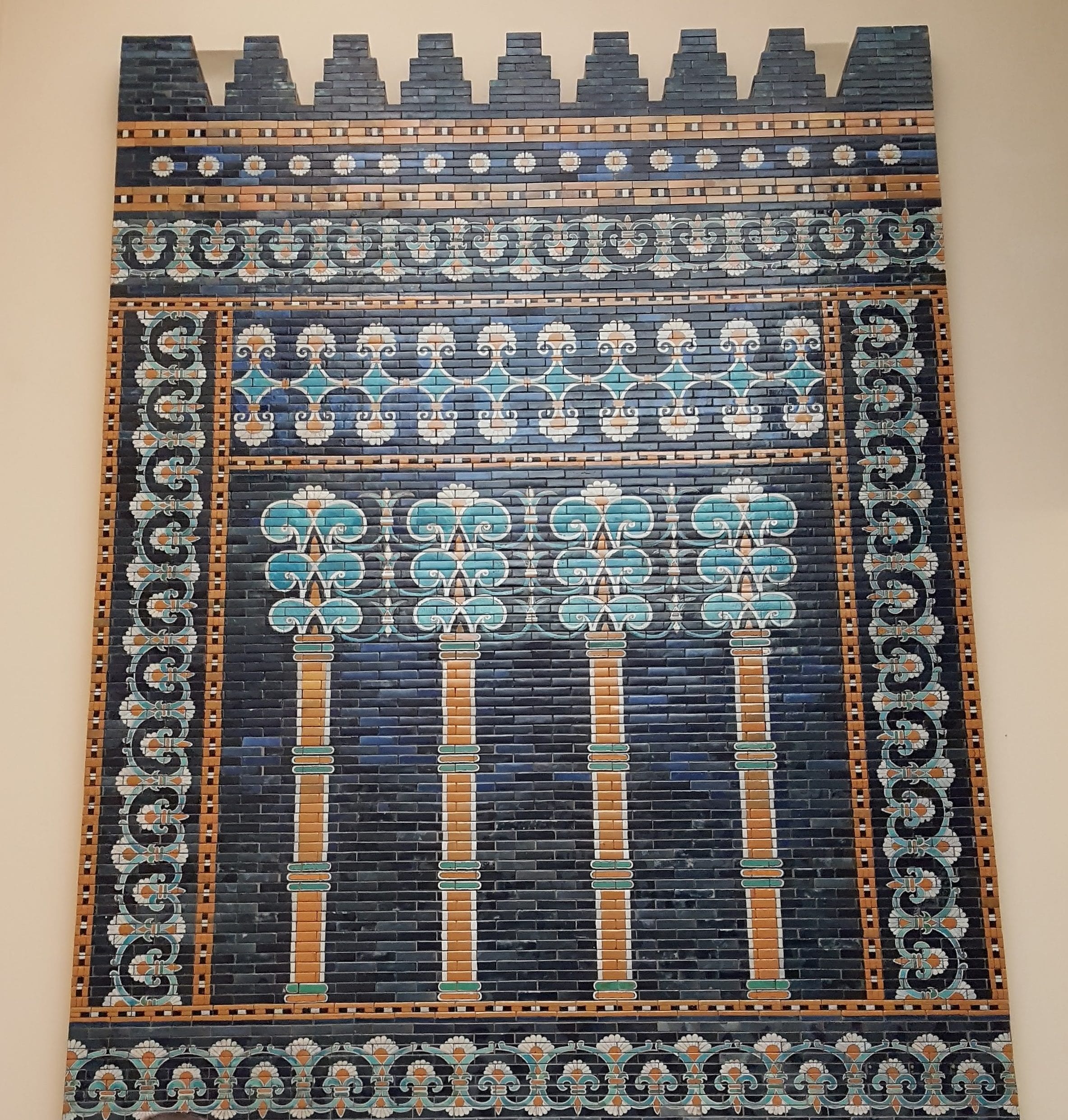
A front panel from the Ishtar Gate, built in Babylon by Nebuchadnezzar in the 6th century BC
Since the Iron Curtain now exists only in memory and we are here in Berlin, we figured that all that stood between us and these wonders of the ancient world would be a 45-minute wait in the long queue outside the museum, but we soon learned that we still would not have a chance to see the Altar of Zeus. From a sign posted at a bend in the line, we learned that the hall housing the Pergamon exhibit has been closed for remodeling since 2014 and is not scheduled to reopen until 2020; however, the Ishtar Gate and countless other ancient artifacts are still on display, as is the museum’s collection of Islamic art–so there was still plenty to see.
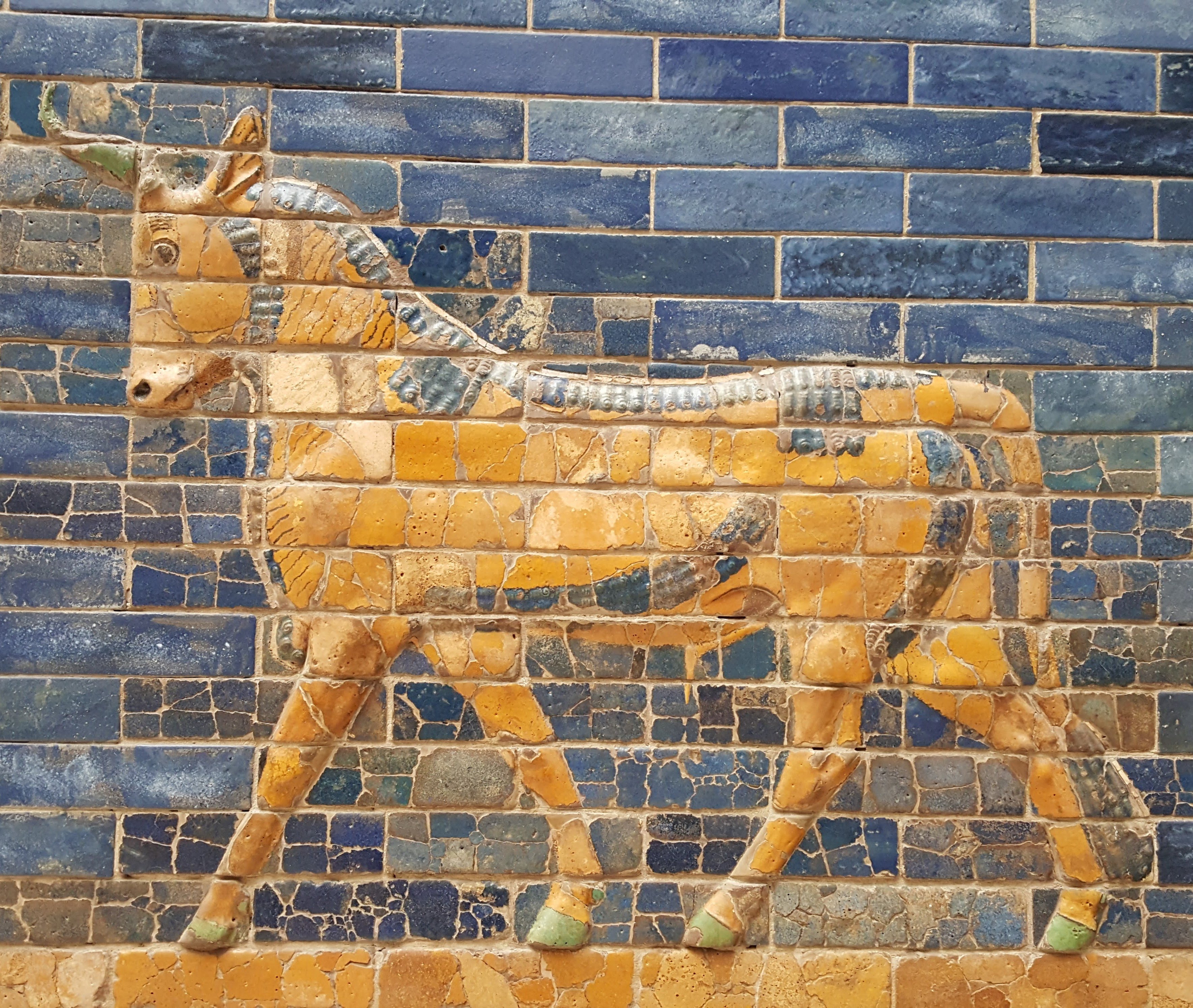
The aurochs, a type of wild ox that is now extinct, represents Adad, the Babylonian rain god
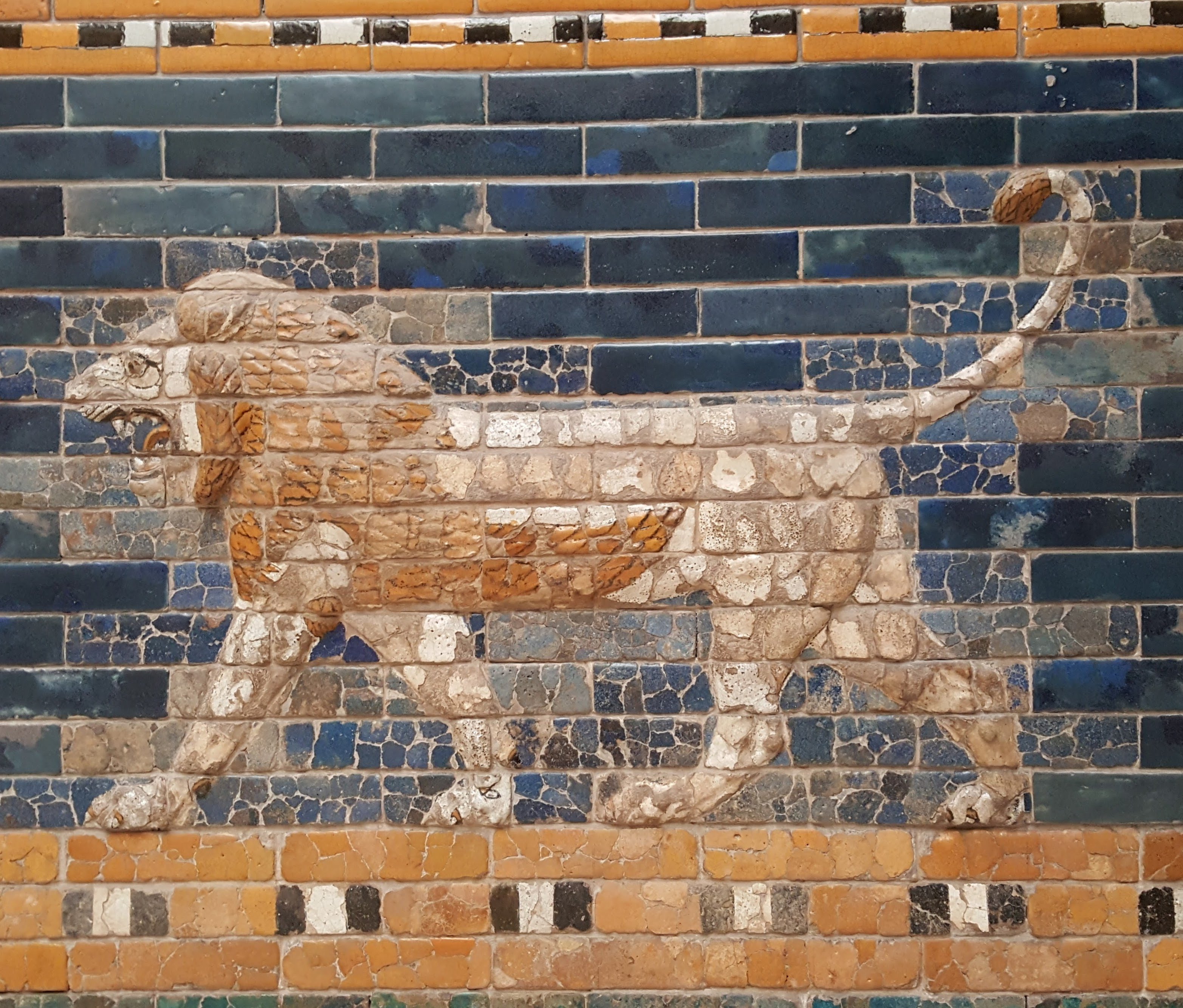
The lion represents Ishtar, goddess of war and protector of Babylon
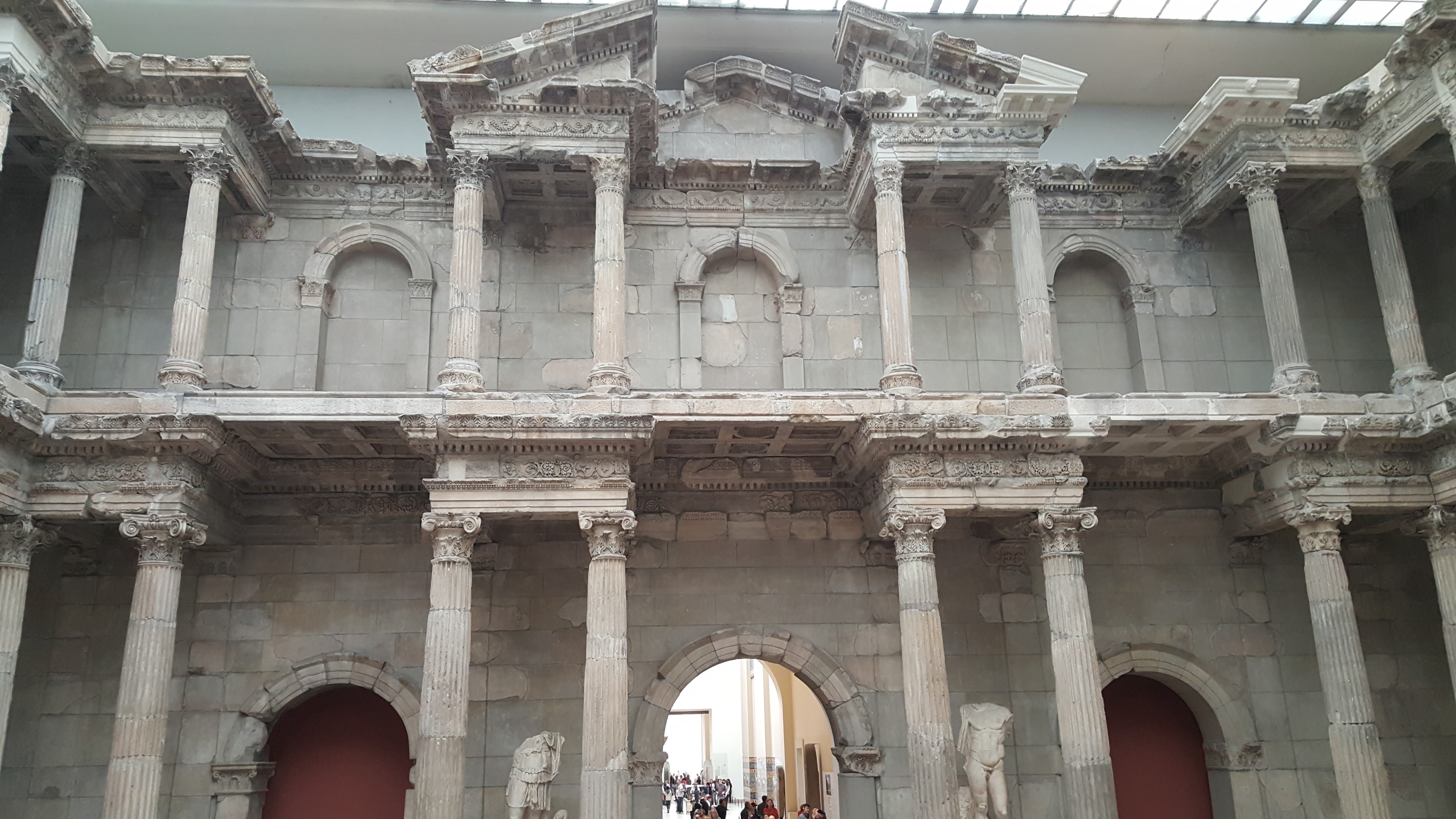
The Market Gate from Miletus, a town on the Meander River in what is now Turkey that thrived on trade in wool and purple dye during the 1st and 2nd centuries AD

Portion of walls from the Court of the Caliph at the Mschatta Palace, located south of present-day Amman, Jordan. Mschatta was the “winter camp” of the Umayyad caliph al-Wahid II, but was left uncompleted after the caliph was assassinated in 744 AD. (Scale: a person of average height might come up to the top horizontal line at the base)
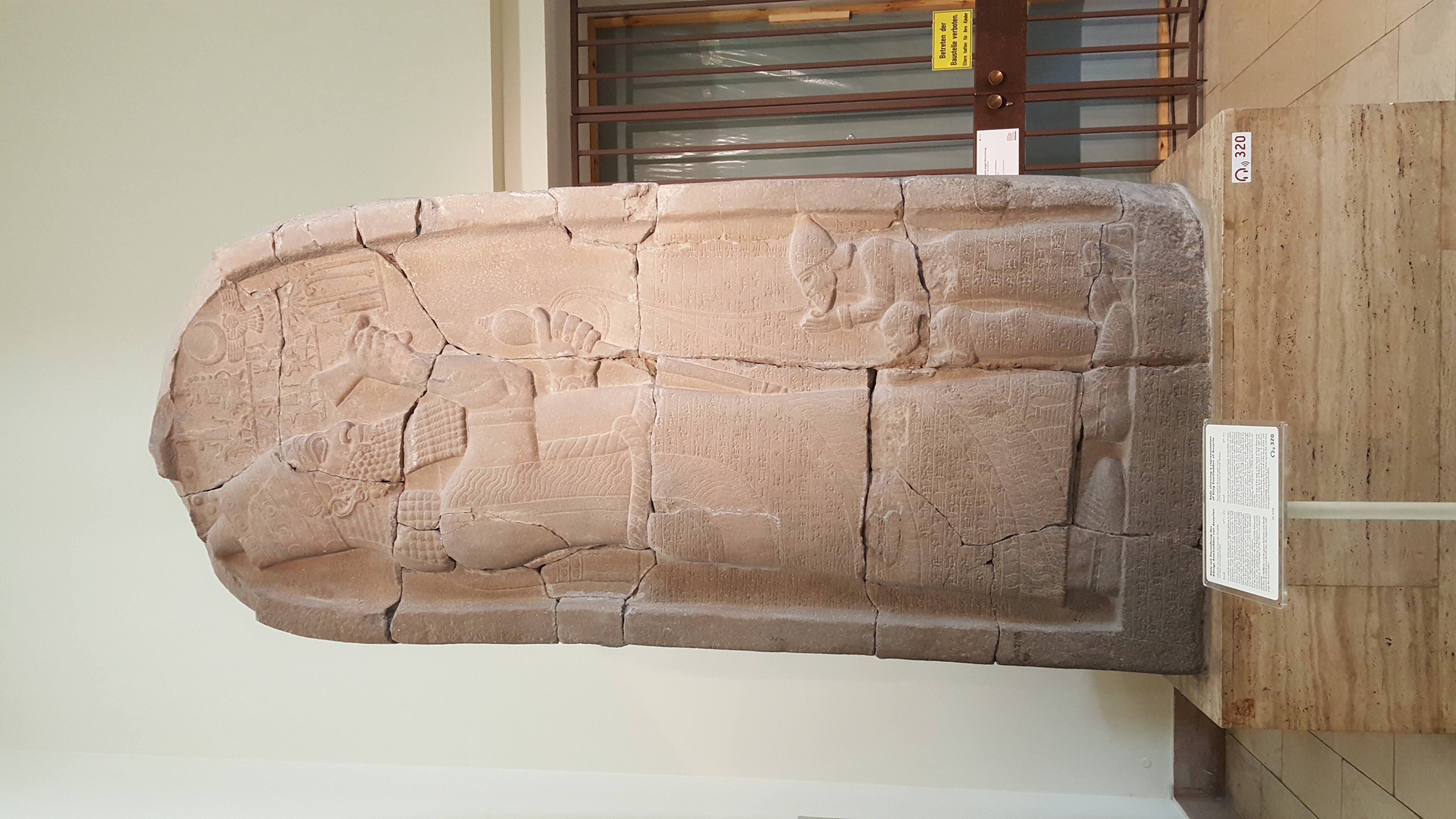
Stele depicting King Esarhaddon of Assyria lording it over the conquered rulers of Egypt and Syria, 621 BC
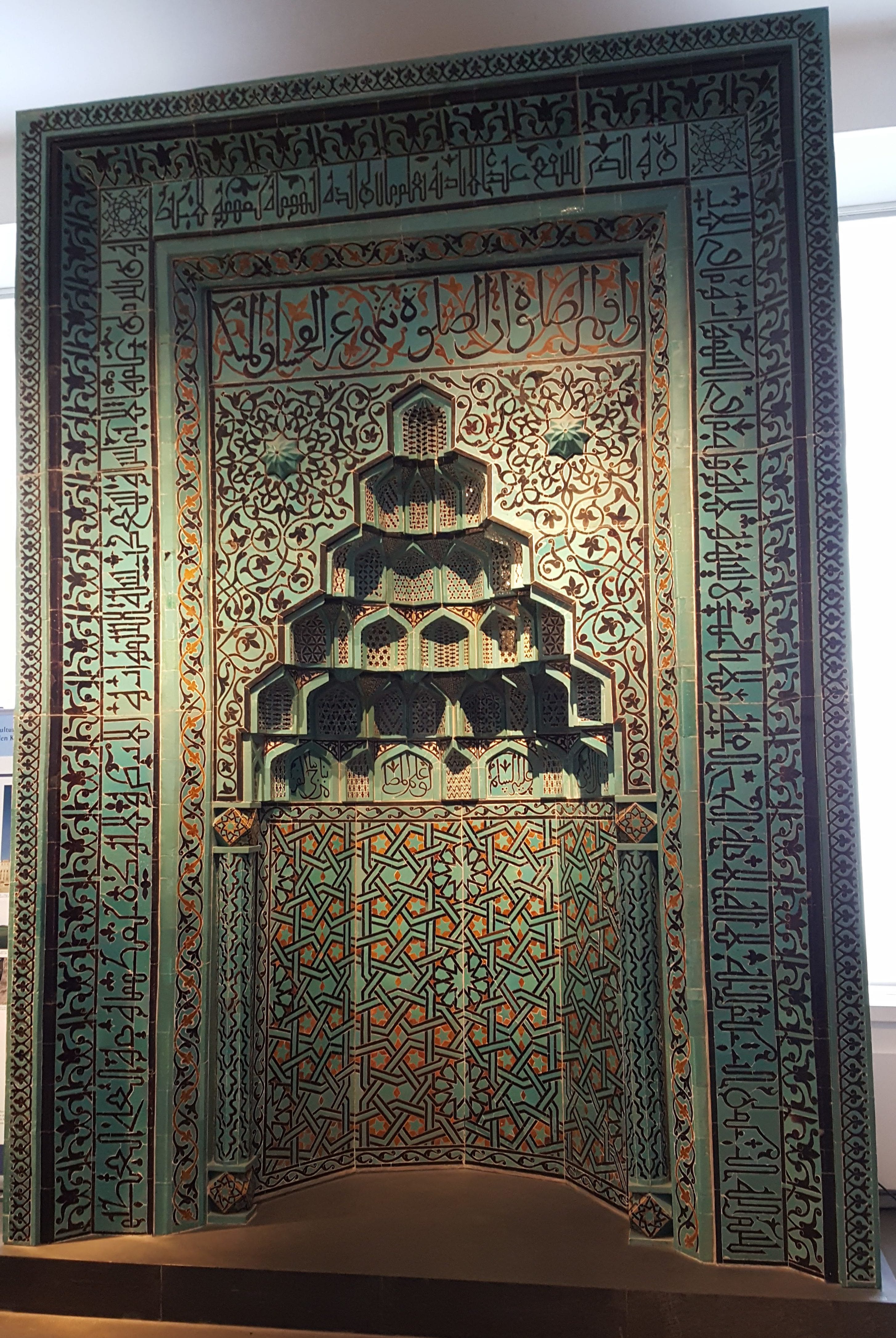
Ceramic prayer niche, Ayyubid dynasty, Raqqa, Syria, c. 1200 AD. Centuries ago, Raqqa was famous for its ceramics industry; currently, it’s in the news as the scene of fierce fighting between ISIS and coalition forces
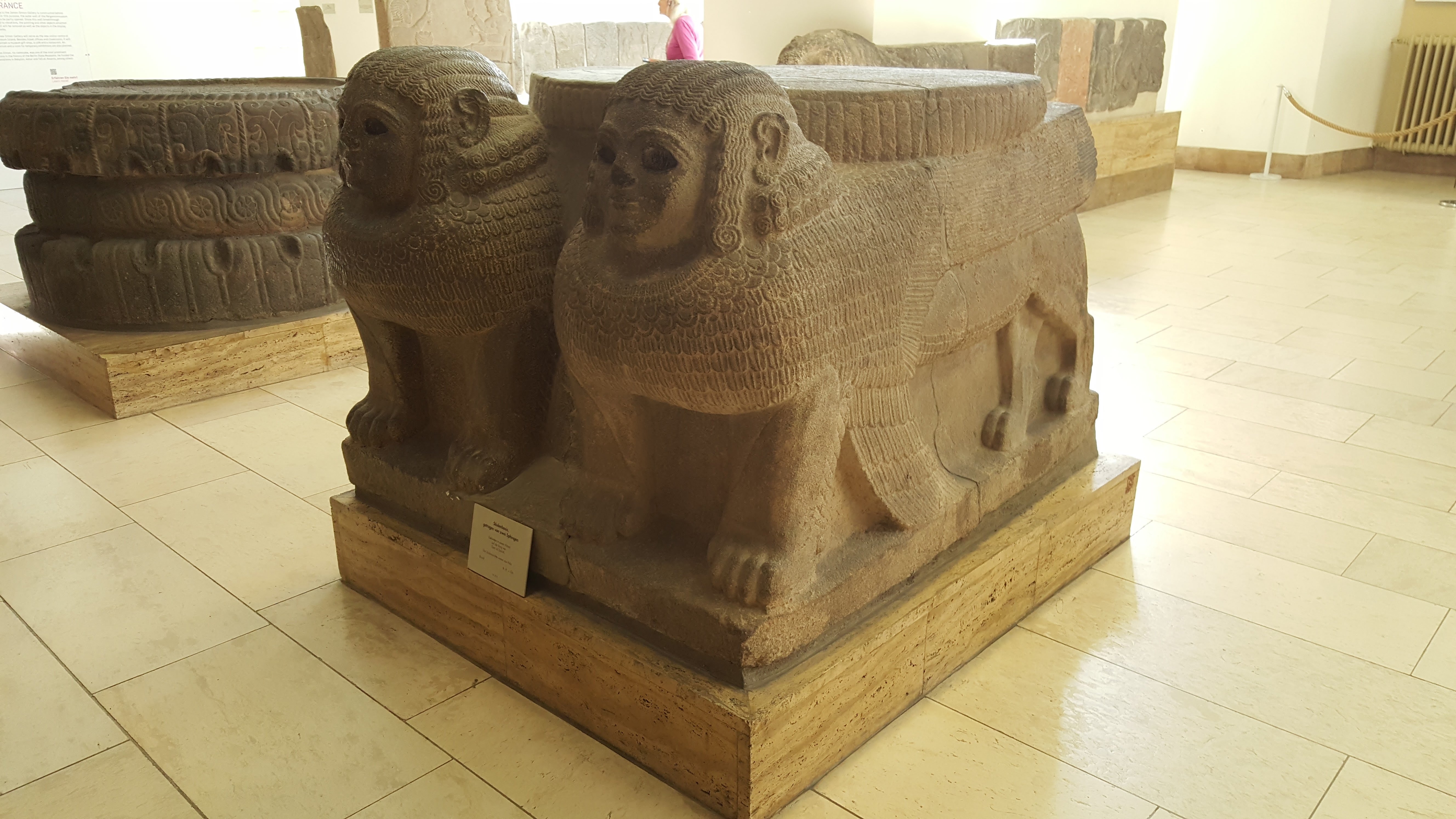
Two sphinxes (c. 800 BC) formed the base of a column from Sa’mal, an independent city-state (located near Zincirli, Turkey) in the 10th-8th centuries BC
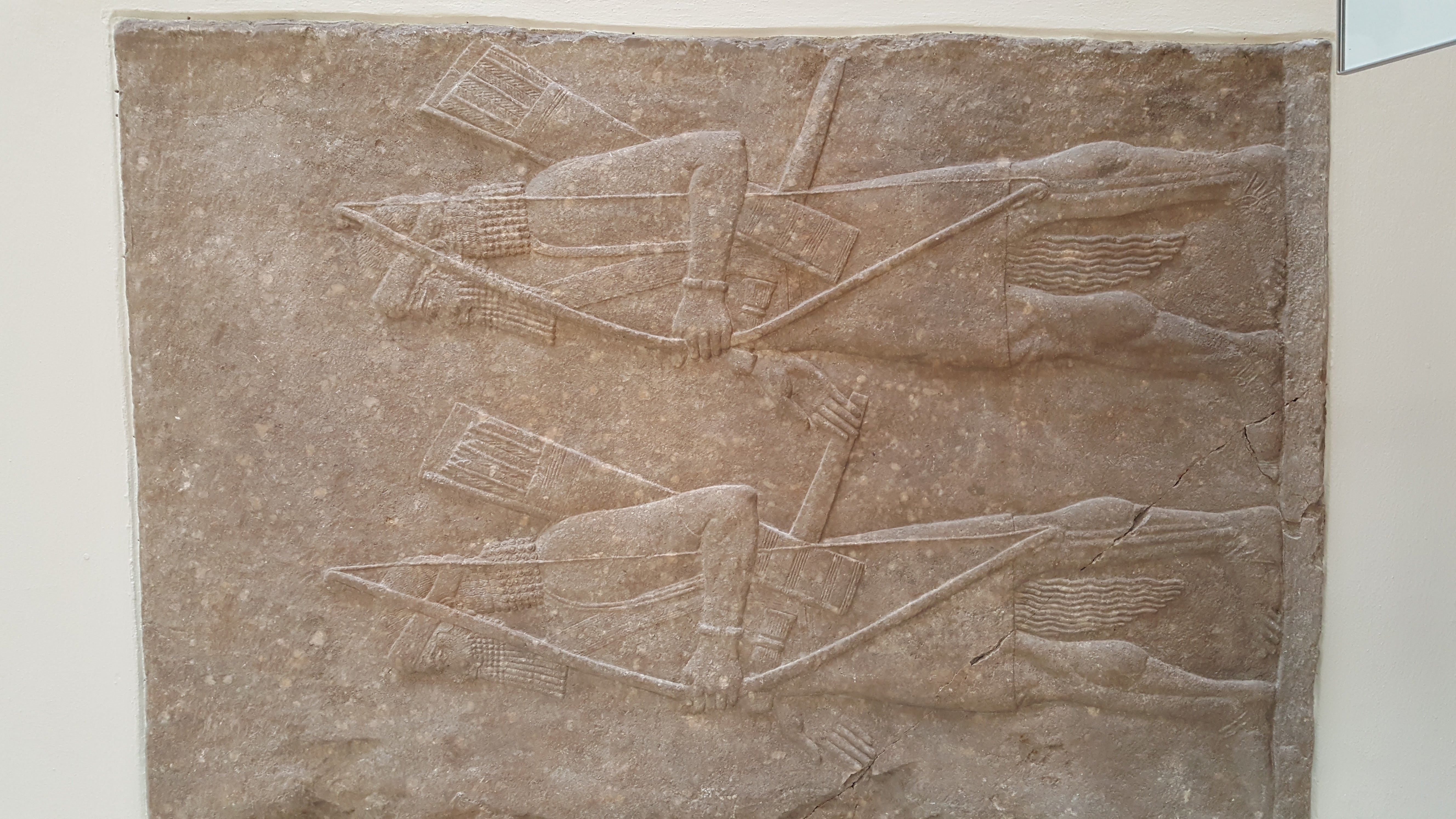
Assyrian archers, Nineveh, c. 715 BC
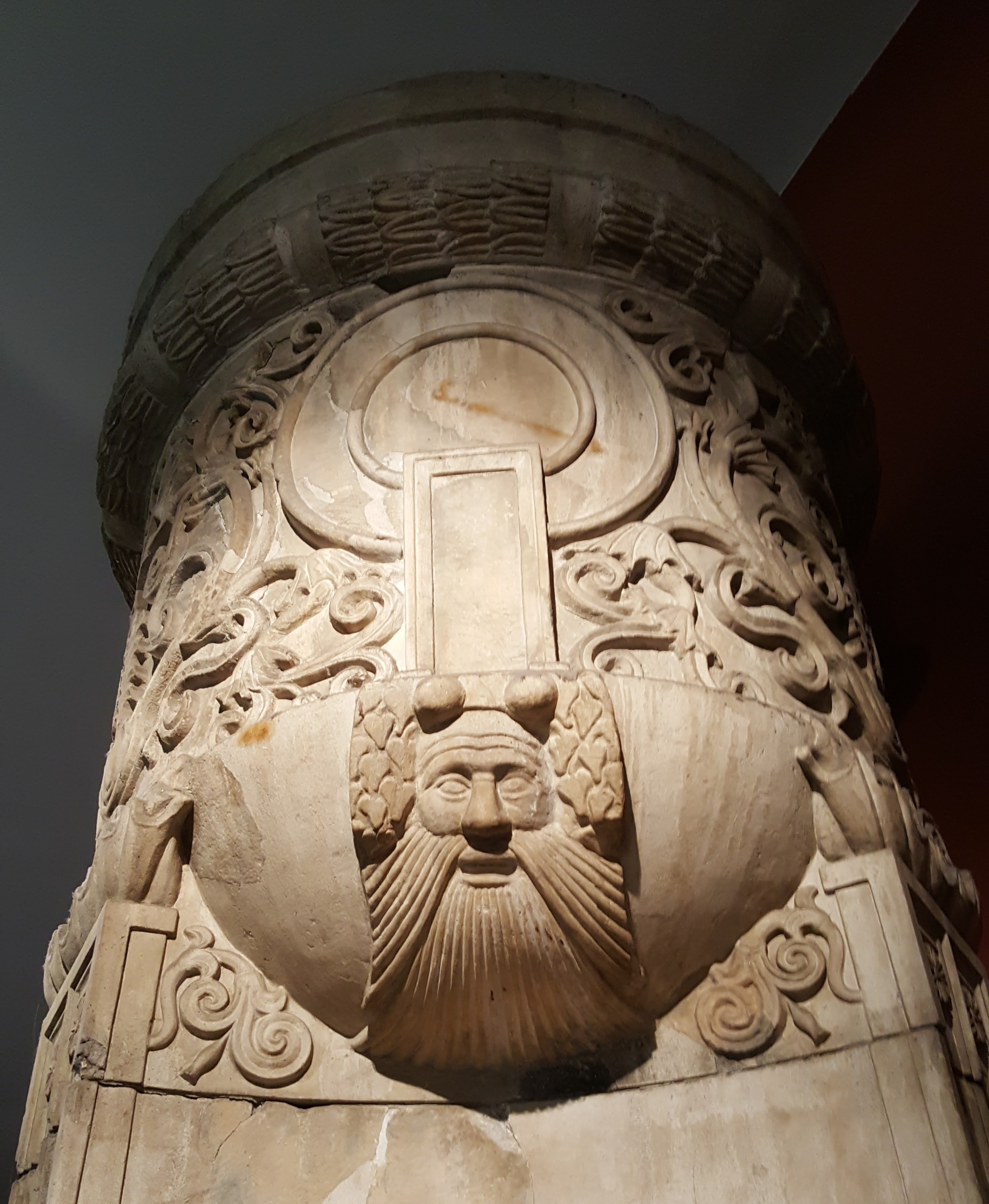
Tripod from the Miletus town hall
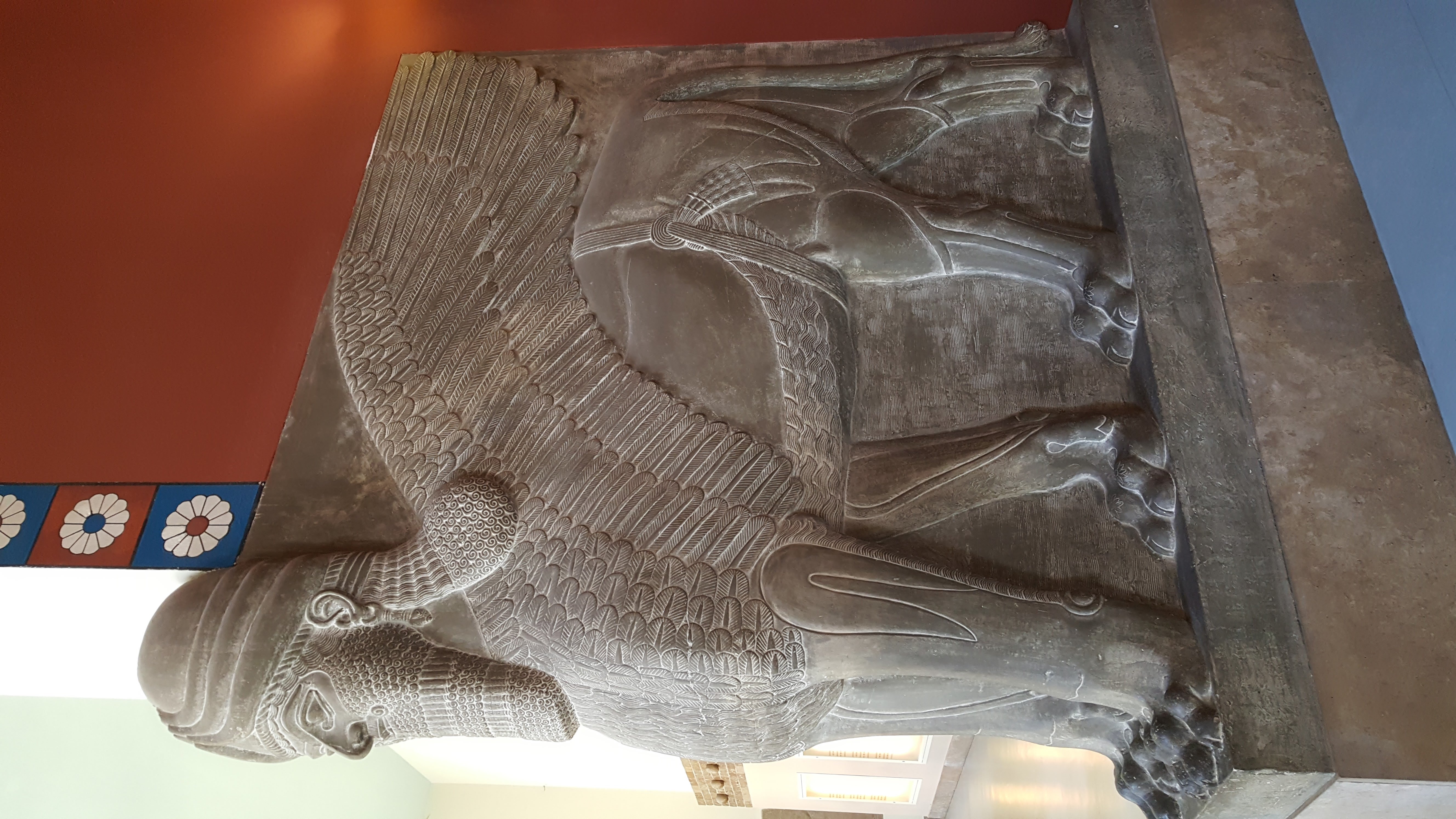
This guardian statue from the palace of Tukulti-Ninurta, king of Assyria in the 13th century BC, resembles the cherubim of Solomon’s temple in Jerusalem
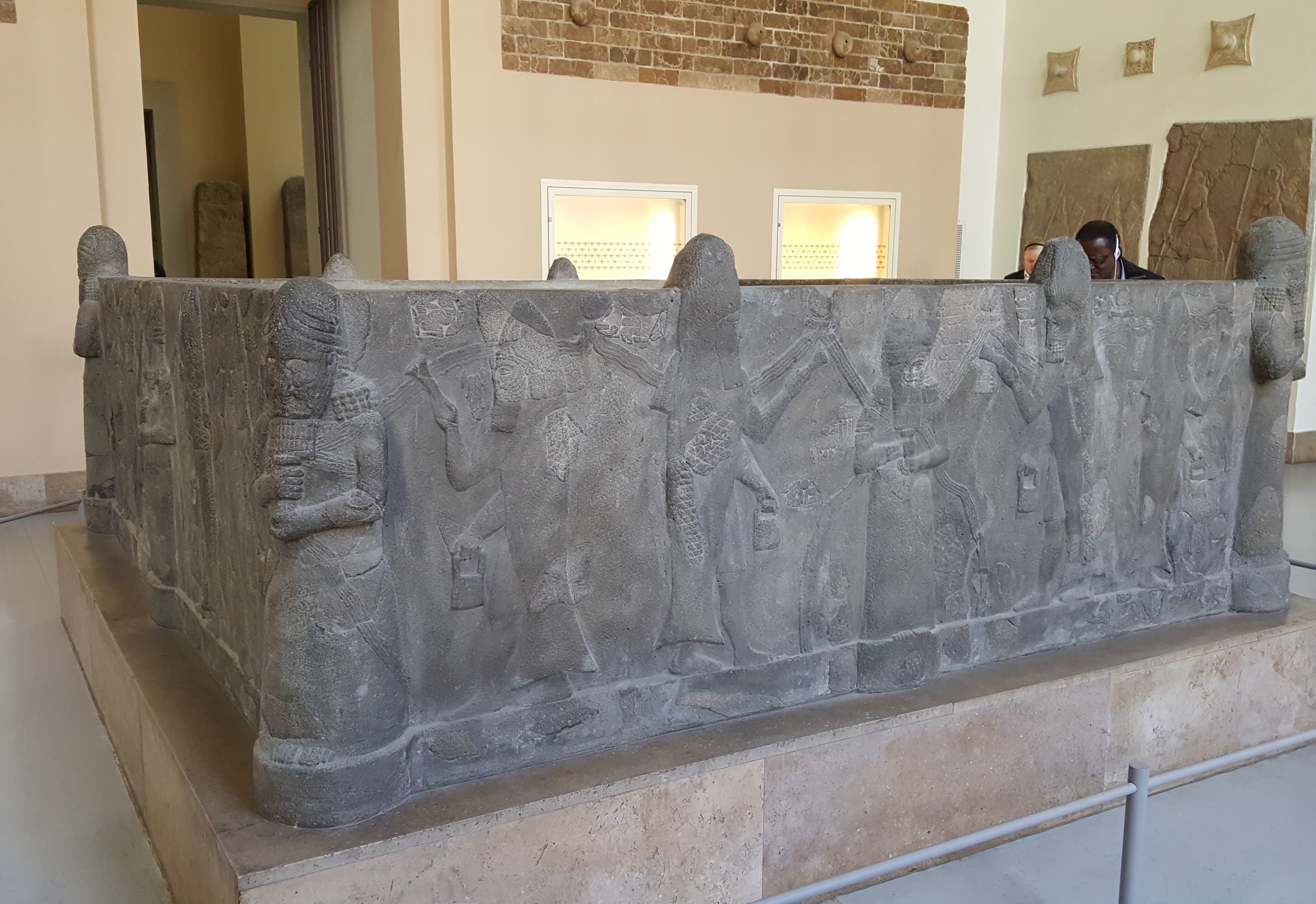
The name of Sennacherib, king of Assyria in the 7th century BC, appears several times on this water basin from the Temple of Ashur
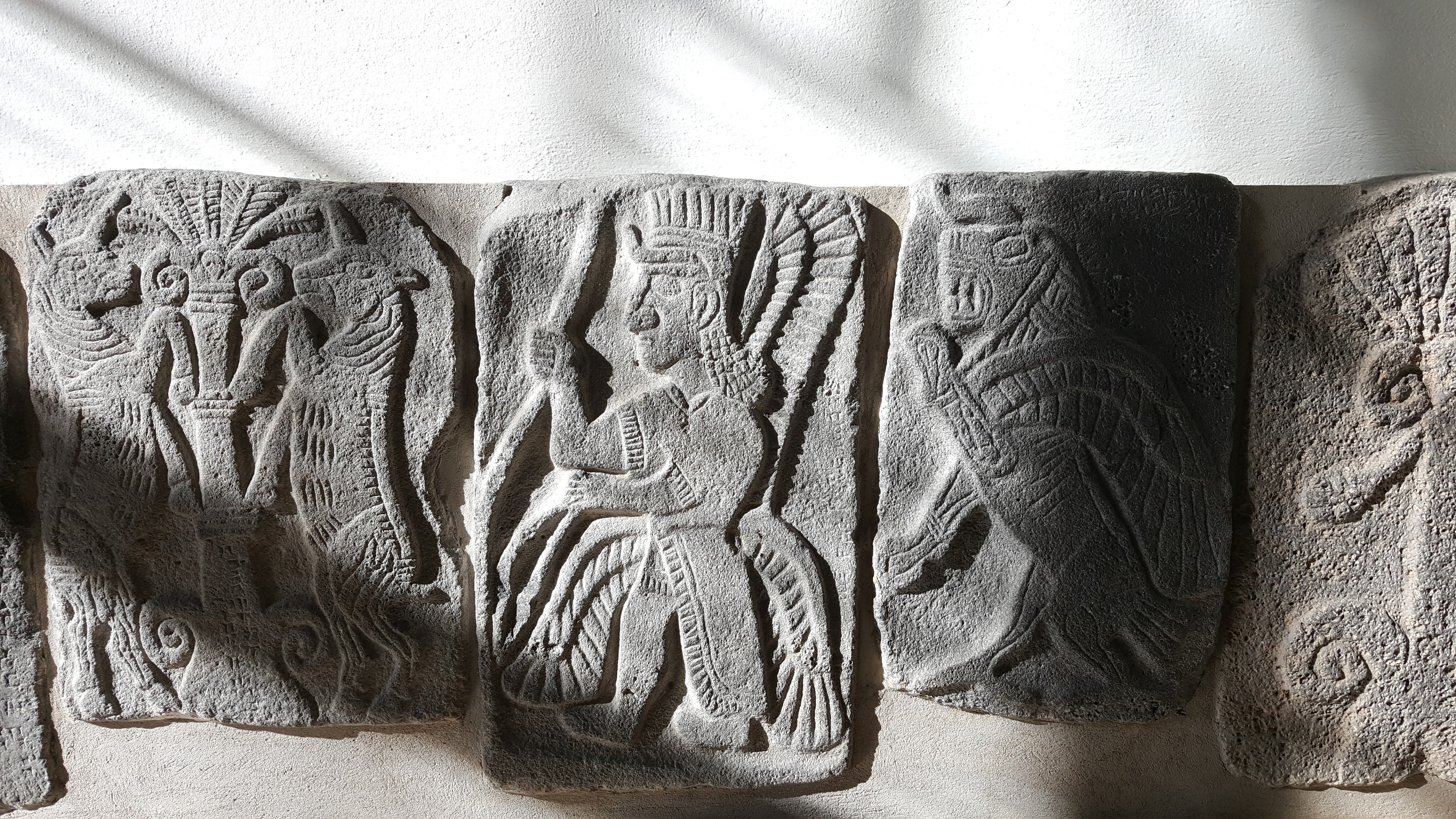
Neo-Hittite/Aramaean relief panels from the Palace Temple in Tell Halaf, Syria, 9th century BC. We think they bear a striking resemblance to pre-Columbian art of the Americas
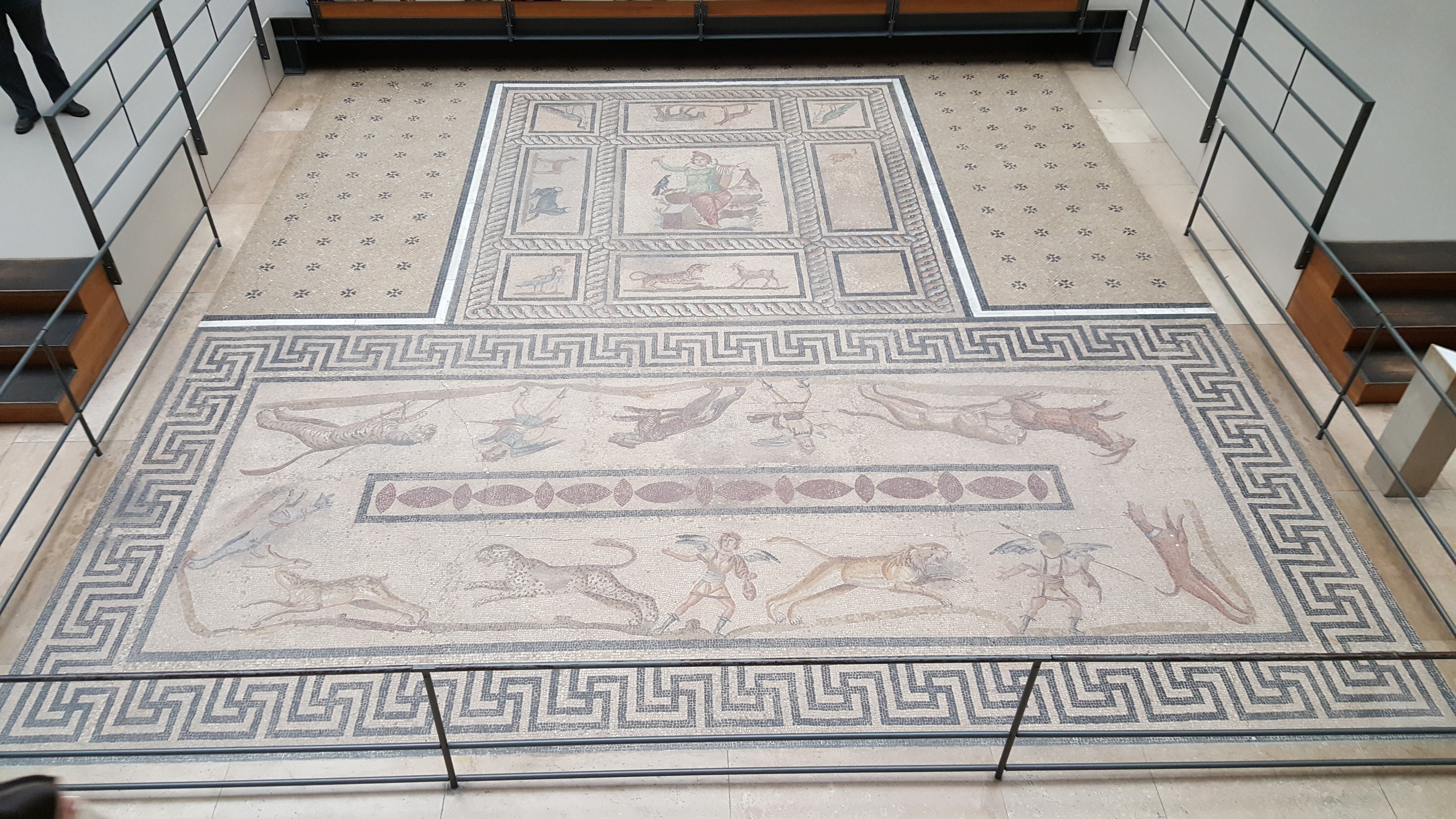
Mosaic floor from a triclinium dining hall in Miletus, c. 200 AD
While we enjoyed seeing carefully reconstructed, priceless examples of ancient architecture such as the monumental Ishtar Gate, the towering Market Gate of Miletus, and the impressive Mschatta Façade, Nancy had mixed feelings about seeing them inside a Berlin museum, far from their original settings and divorced from their native cultures. She could appreciate the desire of the nineteenth-century explorers and archaeologists who uncovered these artifacts to preserve and protect them, and to display them where more people would be likely to encounter them. But having seen such wonders as the Parthenon in Athens, the Celsus Library in Ephesus, and Herod’s Temple in Jerusalem–in the lands where they belonged–today she couldn’t help but feel underwhelmed by the monuments on display within the sterile confines of a museum. The artificial light robs visitors of the opportunity to notice sunlight glinting off the Ishtar Gate’s glazed brick, watch the Miletus Gate’s gray marble turn golden at sunset, or fully enjoy the play of light and shadow in the stone tracery of the Mschatta Façade. Even though the museum’s walls protect these treasures from harm, they also prevent us from smelling pungent aromas from the surrounding marketplace, or the feeling the sting of wind-borne sand as we gaze. There are always trade-offs.
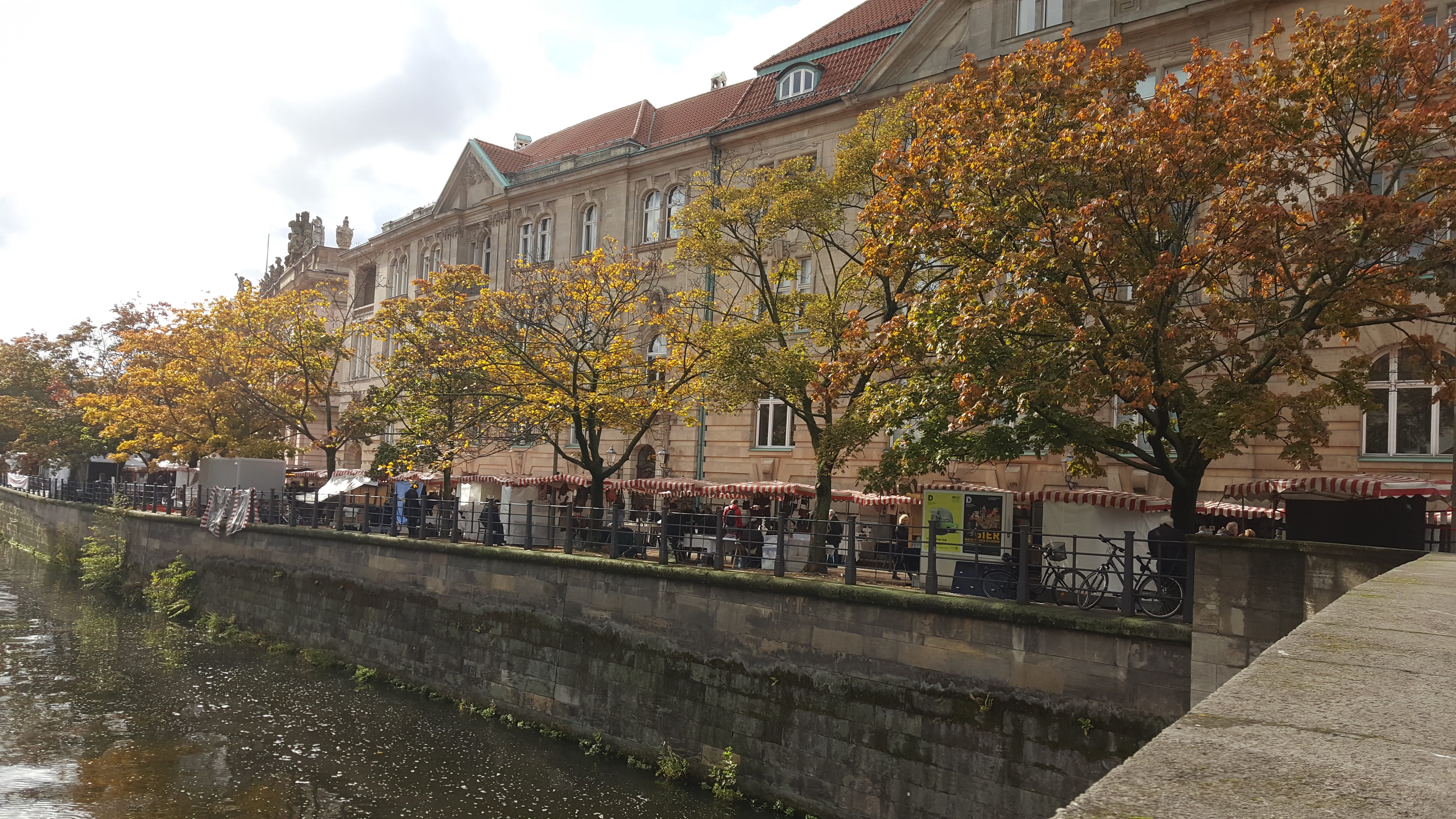
The Sunday market on Museum Island
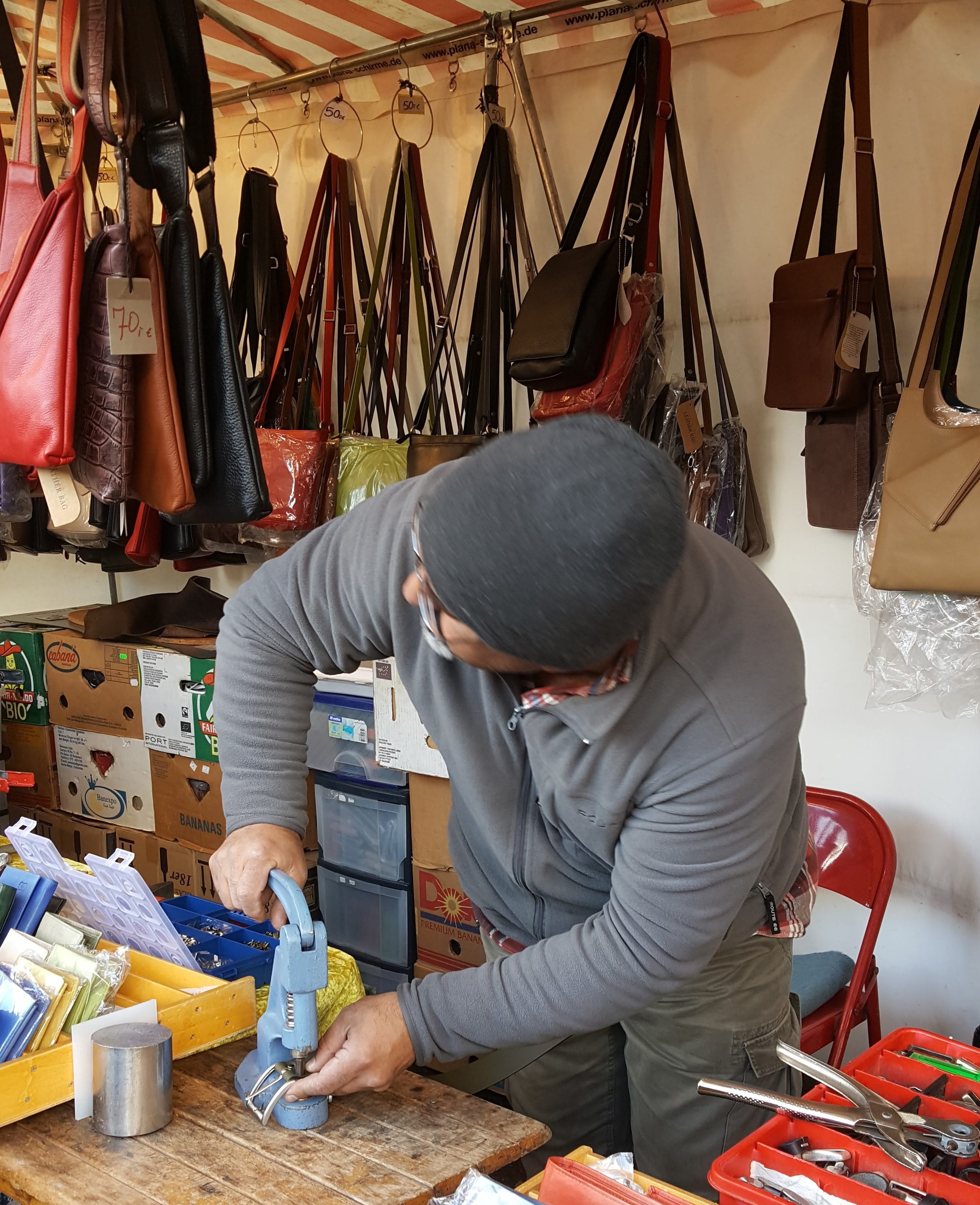
The leatherworker attaches hardware to one of Marty’s new belts
Back outside, we wandered through an open market set up along one of the narrow channels that separate Museum Island from the surrounding city. A leatherworker’s stall caught Marty’s attention because he needed belts to go with two new pairs of shoes: one green, one blue. He was able to find just the right colors, and after he picked out the buckles he wanted, the leatherworker took his waist measurement, trimmed the leather to size, and attached the hardware. Meanwhile, Nancy was attracted to some colorful ceramic windchimes and decided that they would make good Christmas gifts for our kids and their families.
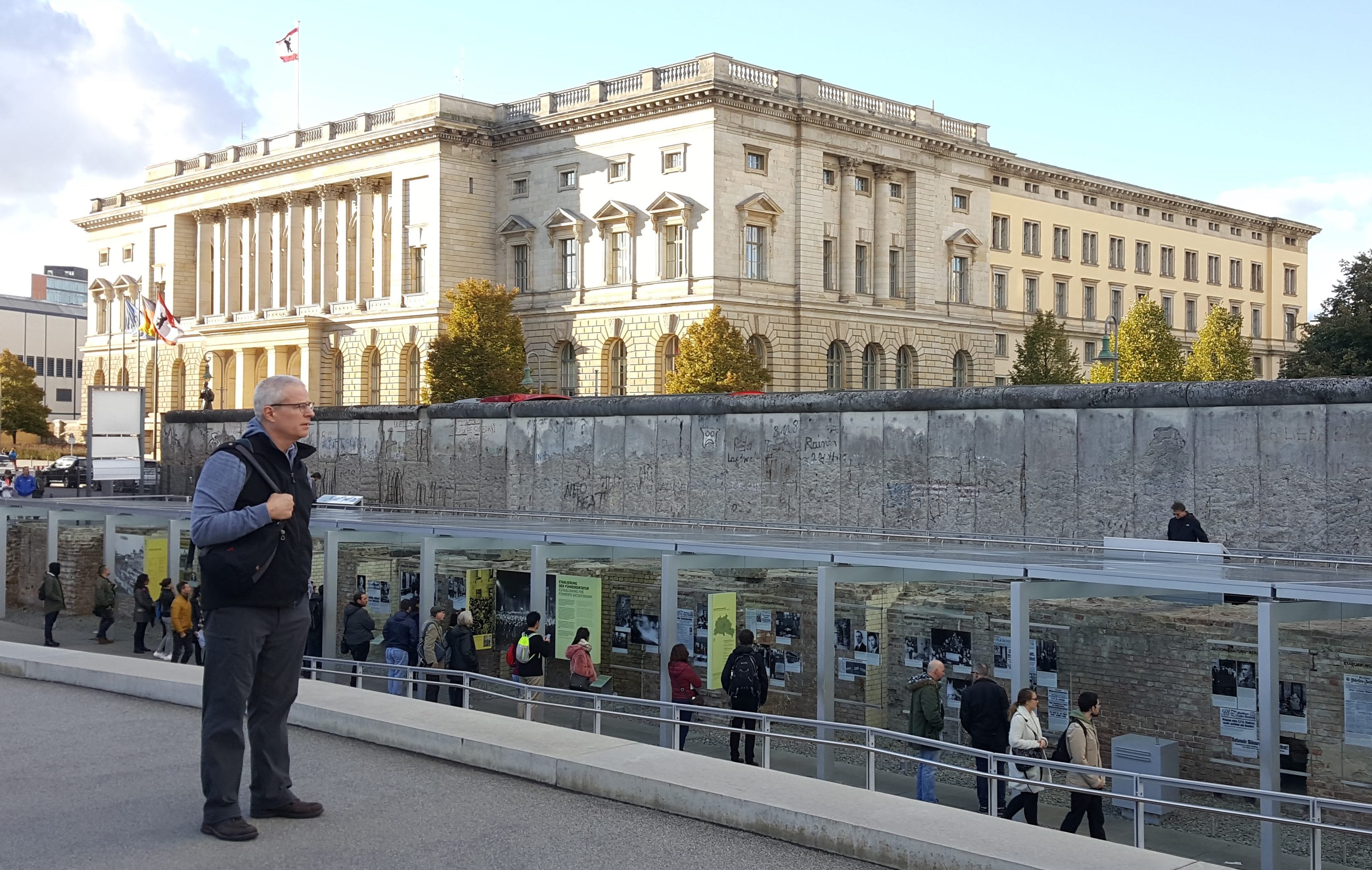
The Abeorgnetenhaus (House of Representatives for the City of Berlin, background) and the Berlin Wall Memorial (foreground)
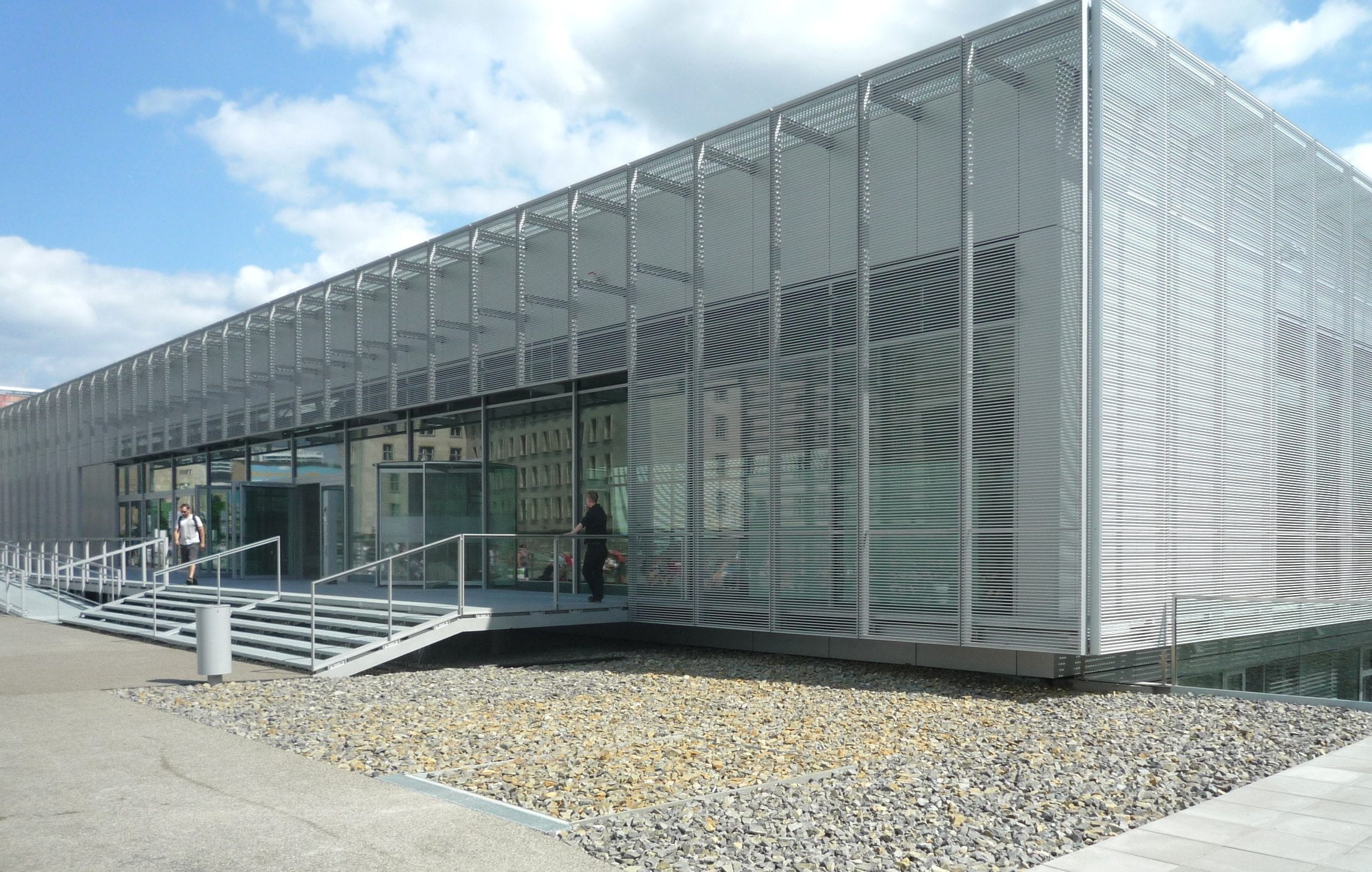
Topographie des Terrors
Satisfied with his purchases, Marty said goodbye; he was going home either to listen to a few more audition recordings or to take a nap. We weren’t quite ready to follow him home, so we caught a bus heading down Leipziger and Wilhelm Strasses toward the Berlin Wall Memorial and the Topography of Terror Museum.
We wished we had skipped the latter. Visiting the museum was like reading a history text focusing on the atrocities of the Nazi regime, illustrated with grainy enlargements of old black-and-white photographs. Within an hour, we decided that we had seen more depressing evidence of official depravity and read more disturbing accounts of human suffering than anyone could possibly tolerate in one afternoon, so we left.
The S-Bahn took us back to Savignyplatz, where the red-brick train station anchors a pleasant collection of little shops, galleries, and cafés. On another day, we might have enjoyed browsing or stopping for a drink, but it was now late afternoon and we realized that the time had come to go back to Marty’s apartment and start packing. Alas, our flight back to the States leaves tomorrow morning at 7:50 a.m.
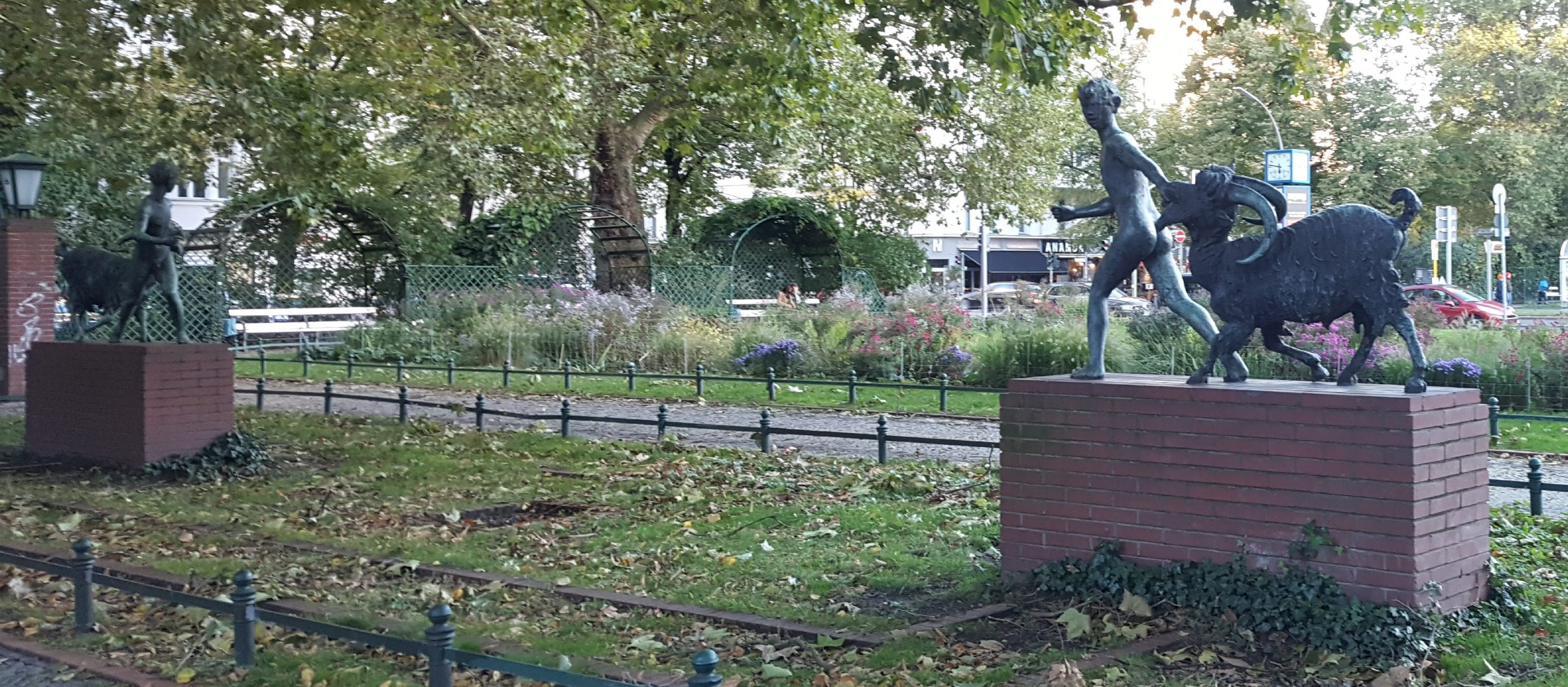
Savignyplatz is named for a 19th-century German legal scholar. The two sculptures by August Kraus, both called “Boy with a Goat” (1928), are mirror images of each other. The platz is surrounded by streets named for other scholars, philosophers, and artists.
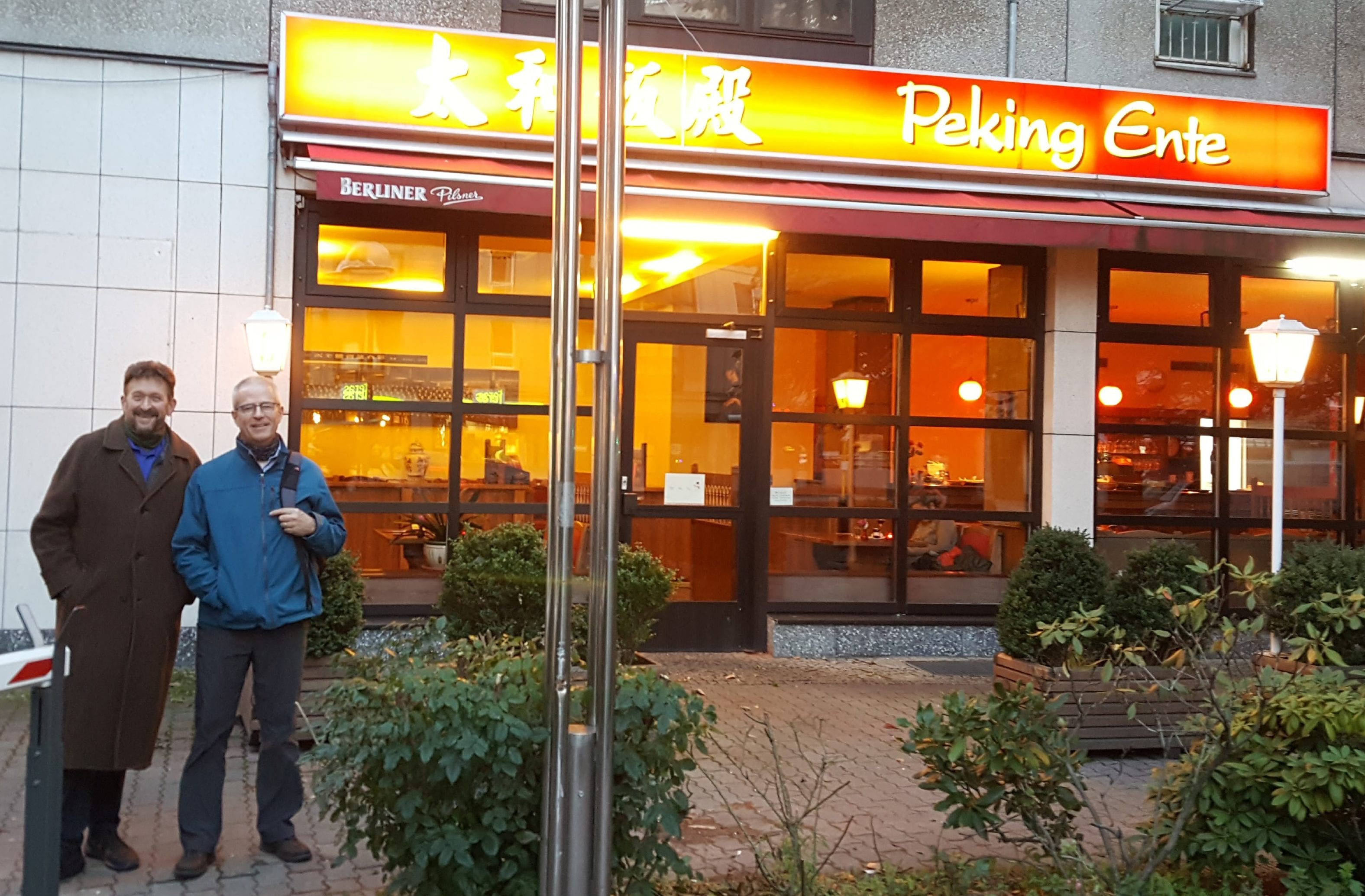
Peking Ente
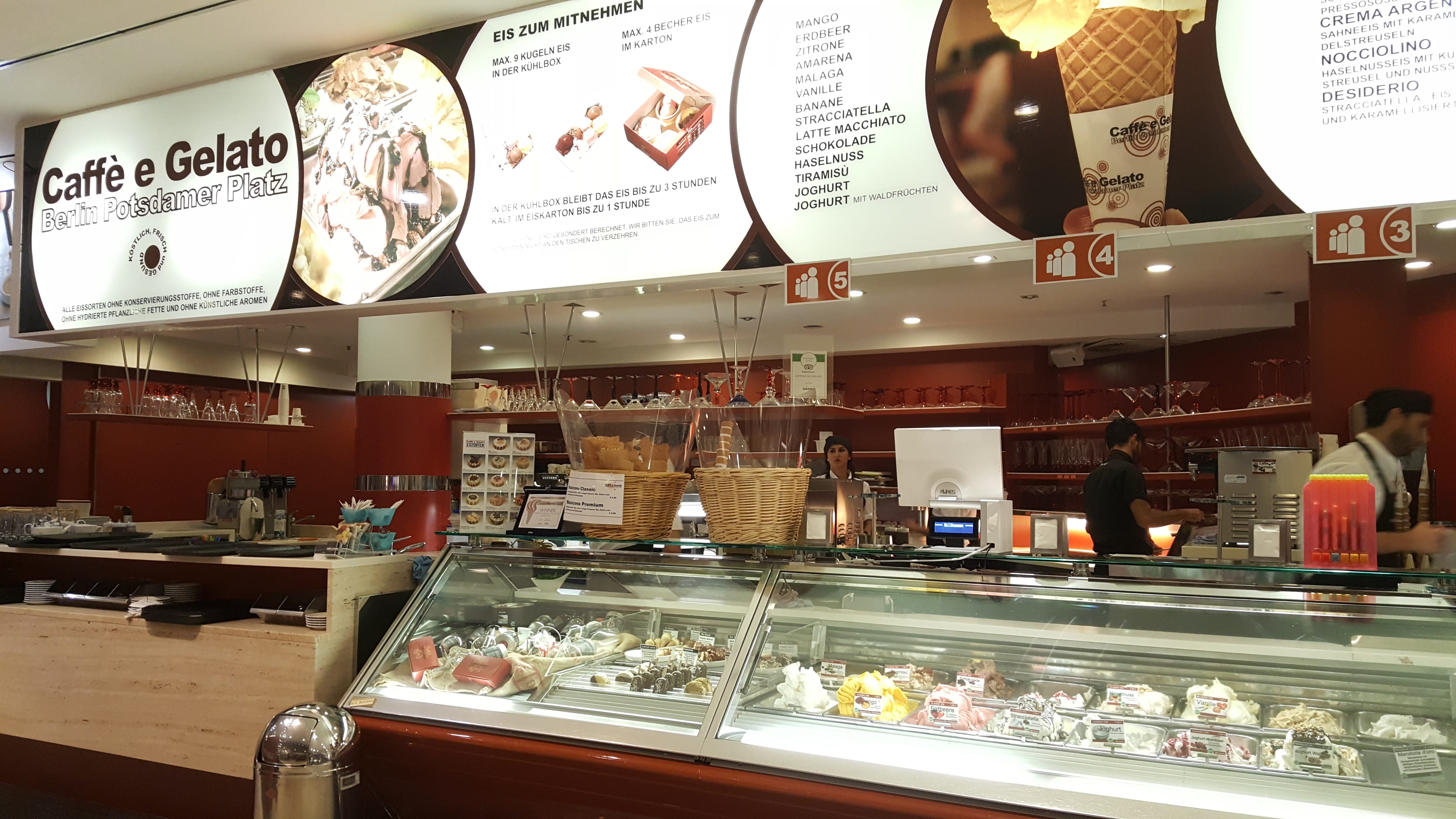
Caffe e Gelato – the best gelato in Berlin
Since Marty had prepared nearly every meal we have eaten during our stay in Berlin, we thought he deserved a night off and offered to take him out for dinner. He readily accepted and chose Peking Ente near Potsdamer Platz. We had planned to order the restaurant’s eponymous Peking Duck, but once we got seated and had perused the menu, we decided that a whole grilled duck with a dozen pancakes was probably more than the three of us needed to consume. Instead, we ordered plates of crispy duck breast with chicken and pepper beef, served with Chinese cabbage–all of which was delicious, but left us enough room for gelato, which we obtained from a Caffè e Gelato store in a shopping mall down the street.
Back at the apartment, we finished packing about 10 p.m., said goodnight and goodbye to Marty, and went to bed. The alarm was set to go off at 3:30 a.m.
Leave A Comment